Introduction
The results reported in the October 2021 bank lending survey (BLS) relate to changes observed during the third quarter of 2021 and expectations for the fourth quarter of 2021. The survey was conducted between 20 September and 5 October 2021. A total of 146 banks were surveyed in this round, with a response rate of 100%. In addition to results for the euro area as a whole, this report also contains results for the four largest euro area countries.[1]
A number of ad hoc questions were included in the October 2021 survey. They address the impact of the situation in financial markets on banks’ access to retail and wholesale funding, the impact of the ECB’s asset purchase programmes (APP and PEPP), the impact of the ECB’s negative deposit facility rate and the ECB’s two-tier system, and the impact of TLTRO III on banks and their lending policies.
1 Overview of results
In the October BLS round, euro area banks indicated broadly unchanged credit standards on loans to enterprises in the third quarter of 2021, i.e. the percentage share of banks reporting a tightening and the share of banks reporting an easing of credit standards were broadly identical. Banks kept credit standards broadly unchanged for the second consecutive quarter, after the stronger tightening earlier in the pandemic crisis. This suggests that despite supply bottlenecks banks maintain a balanced view of their credit risks, in line with the economic recovery in the last two quarters and the continued support from monetary, fiscal and supervisory authorities. In addition, banks reported that risk perceptions and competition from other banks had a slight net easing impact, while banks’ risk tolerance and cost of funds and balance sheet constraints had a broadly neutral impact. In the fourth quarter of 2021, banks expect a moderate net tightening of credit standards for loans to firms.
Demand for loans to firms increased slightly in the third quarter of 2021, according to banks, in line with muted developments in actual loan growth to non-financial corporations (NFCs) in the euro area. Loan demand continued to be supported by firms’ financing needs for fixed investment, the low general level of interest rates, mergers and acquisitions (M&A) and debt refinancing and restructuring. Financing needs for inventories and working capital also contributed positively to loan demand. At the same time, internal financing and alternative external financing sources dampened loan demand. In the fourth quarter of 2021, banks expect a net increase in demand for loans to firms.
Banks adopted a more cautious attitude towards housing loans, reporting a net tightening of credit standards for such loans, while credit standards remained broadly unchanged for consumer credit in the third quarter of 2021. For housing loans, the net tightening was related to banks’ risk tolerance and their cost of funds and balance sheet constraints, whereas these factors had a broadly neutral impact for consumer credit. Banks reported, on balance, a further increase in demand for loans to households for house purchase and consumer credit in the third quarter of 2021. Developments in consumer confidence, the low general level of interest rates and housing market prospects contributed positively to loan demand by households. In the fourth quarter of 2021, banks expect a further net tightening of credit standards and, on balance, no change in demand for loans to households for house purchase.
In more detail, credit standards (i.e. banks’ internal guidelines or loan approval criteria) for loans or credit lines to enterprises remained broadly unchanged in the third quarter of 2021 (net percentage of banks of 1%, after -1% in Q2 2021; see Section 2.1). This was in line with expectations from the last round and applied to both small and medium-sized enterprises (SMEs) and large enterprises (net percentages for both stood at 0% in Q3 2021). Following the stronger tightening in the second half of 2020 and in the first quarter of 2021, banks kept credit standards broadly unchanged in the last two rounds. This suggests that despite supply bottlenecks banks maintain a balanced view of their credit risks, in line with the economic recovery in the last two quarters and the continued support from monetary, fiscal and supervisory authorities. In the fourth quarter of 2021, euro area banks expect a moderate net tightening of credit standards for loans to firms (3%).
Risk perceptions and competition from other banks had a slight easing impact on credit standards for loans to firms in the third quarter of 2021, while banks’ risk tolerance and their cost of funds and balance sheet constraints had a broadly neutral impact. The general economic situation continued to have a net easing impact on credit standards, which is reflected in the first slight net easing of overall risk perceptions since the third quarter of 2018. Banks’ risk tolerance had no further tightening impact on credit standards for loans to firms for the first time since the pandemic crisis started. In line with previous quarters, banks’ cost of funds and balance sheet constraints had a broadly neutral impact on credit standards, which was supported by an easing impact of their liquidity situation. Finally, overall competition had a broadly neutral impact on credit standards, while competition from other banks had a net easing impact.
In the third quarter of 2021, euro area banks reported a net tightening of credit standards for housing loans (net percentage of banks of 8%, after -1% in Q2 2021; see Section 2.2), while credit standards remained broadly unchanged for consumer credit and other lending to households (-1%, after 0%; see Section 2.3). For housing loans, banks’ lower risk tolerance as well as their cost of funds and balance sheet constraints had a tightening impact, while these factors had a broadly neutral impact for consumer credit. In addition, risk perceptions and competition had a broadly neutral impact on credit standards for all lending to households. Banks expect credit standards to tighten further for housing loans (6%) and to ease slightly for consumer credit (-2%) in the fourth quarter of 2021.
Banks’ overall terms and conditions (i.e. banks’ actual terms and conditions agreed in the loan contract) for new loans to enterprises continued to ease slightly in the third quarter of 2021 (net percentage of -2%, after -5%). Margins on average loans (defined as the spread over relevant market reference rates) narrowed in net terms, while margins on riskier loans increased moderately. The developments in margins reflect the broadly stable lending rates for firms in recent months. Changes in overall terms and conditions as well as margins on average loans were mainly driven by an easing impact of competition. Banks reported on balance a moderate net tightening of overall terms and conditions for housing loans (net percentage of 5%, after -3%) and broadly unchanged terms and conditions for consumer credit and other lending to households (-1%, after -6%) in the third quarter of 2021.
In the third quarter of 2021, the share of rejected applications for loans to firms remained broadly unchanged (net percentage of 1%, after 0%). For housing loans, euro area banks reported on balance a slight increase in the share of rejected applications (2%, after 11%), while the share of rejected applications decreased slightly in net terms for consumer credit (-2%, after 1%).
Among the largest euro area countries, credit standards for loans to enterprises tightened in Germany, remained unchanged in Spain and France, and eased in Italy in the third quarter of 2021 (see Overview table). Credit standards for housing loans tightened in Germany, Spain and France, and remained unchanged in Italy. Credit standards for consumer credit and other lending to households eased in Germany and Italy, remained unchanged in France and tightened in Spain.
Firms’ demand for loans in the third quarter of 2021 increased slightly in net terms according to the banks (net percentage of 2%, after 8% in Q2 2021; see Section 2.1) following the moderate increase in the previous quarter. This is in line with muted developments in actual loan growth to NFCs in the euro area. Loan demand continued to be supported by firms’ financing needs for fixed investment for the second consecutive quarter, providing a positive sign for the economic recovery. In addition, banks continued to report a positive net impact on loan demand from the low general level of interest rates and other financing needs, which include M&A activity and debt refinancing and restructuring. Financing needs for inventories and working capital also contributed positively to firms’ loan demand. At the same time, alternative financing sources, in particular internal financing and loans from other banks and from non-banks lowered loan demand. In the fourth quarter of 2021, banks expect a net increase in demand for loans to firms (net percentage of 23%).
Banks reported on balance a continued increase in demand for housing loans, which was more contained after the strong increase in the previous quarter (net percentage of 11%, after 36% in Q2 2021; see Section 2.2). For consumer credit, banks indicated a more moderate net increase in demand in the third quarter of 2021 (net percentage of 7%, after 11%; see Section 2.3). Improved consumer confidence and the low general level of interest rates continued to have a positive impact on demand for all loans to households. Financing needs related to debt refinancing had a positive impact on the demand for housing loans. In addition, housing market prospects contributed positively to demand for housing loans, while increased spending on durables contributed positively to demand for consumer credit, likely reflecting the improved economic outlook. Banks expect broadly unchanged net demand for housing loans (-1%) and a net increase in demand for consumer credit (12%) in the fourth quarter of 2021.
Demand for loans to enterprises in Germany and Spain increased on balance, while it remained unchanged in Italy and declined in France in the third quarter of 2021. Net demand for housing loans increased in all four largest euro area countries. For consumer credit, demand increased on balance in Germany, Spain and Italy, while it remained unchanged in France.
Overview table
Latest BLS results for the largest euro area countries
(net percentages of banks reporting a tightening of credit standards or an increase in loan demand)
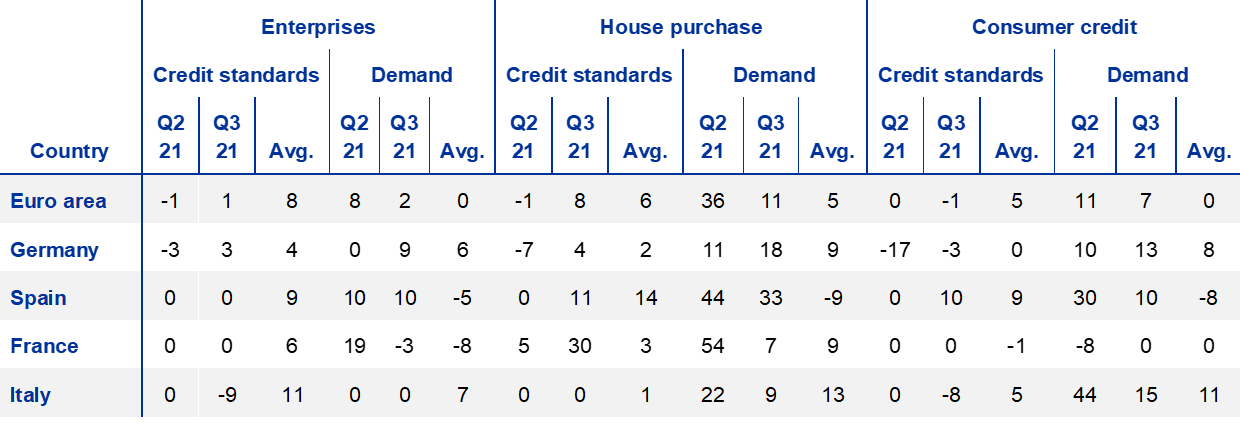
Notes: The “Avg.” columns contain historical averages, which are calculated over the period since the beginning of the survey, excluding the most recent round. For France, net percentages are weighted on the basis of outstanding loan amounts for individual banks in the respective national samples. Owing to the different sample sizes across countries, which broadly reflect the differences in the national shares in lending to the euro area non-financial private sector, the size and volatility of the net percentages cannot be directly compared across countries.
The October 2021 BLS also included a number of ad hoc questions. Regarding euro area banks’ access to retail and wholesale funding, banks reported in net terms that access continued to improve in the third quarter of 2021, especially for retail funding, debt securities and money markets, while the net improvement was smaller for securitisation.
The ECB’s asset purchase programme (APP) and the pandemic emergency purchase programme (PEPP) had a positive net impact on banks’ liquidity position and market financing conditions as well as their lending volumes, and a negative impact on their profitability over the past six months. Banks expect the purchase programmes to have a similar impact on their financial situation over the next six months. Regarding the impact on terms and conditions and credit standards, banks reported that the APP and PEPP had a net easing impact for loans to firms. Over the next six months, banks expect a net easing impact on terms and conditions for loans to firms and housing loans, and a positive impact on lending volumes to firms and households.
With respect to the ECB’s negative deposit facility rate (DFR), euro area banks reported, in net terms, that the DFR lowered lending rates across all loan categories, while it had a positive impact on lending volumes to firms and for housing loans. In addition, the DFR had a negative impact on deposit rates and a positive impact on non-interest rate charges on deposits by firms and households, indicating a continued pass-through of negative rates. According to banks, the DFR had, on balance, a continued negative impact on bank profitability over the past six months. This was however contained by the two-tier system, which had a positive impact on bank profitability compared to the counterfactual situation without such a system, mainly via a positive impact on net interest income. In addition, the two-tier system mitigated the decline in deposit rates for firms and households.
Banks continued to report a positive net impact of TLTRO III funding on their financial situation and their lending volumes as well as a net easing impact on their terms and conditions across all loan categories over the past six months. Participation of BLS banks in the June and September 2021 TLTRO III was more limited compared with previous operations, which is in line with lower overall take-up of TLTRO III funds in the last two operations and in part reflects reduced remaining borrowing allowances of banks due to high previous take-up. Profitability remained the most important reason for banks to participate in TLTRO III, and granting loans remained the most common use of funds. Regarding participation in future TLTRO III, a large share of banks remains undecided. At the same time, banks continued to expect TLTRO III to have a positive impact on their financial situation and their lending volumes, and a net easing impact on terms and conditions.
Box 1
General notes
The bank lending survey (BLS) is addressed to senior loan officers at a representative sample of euro area banks. In the current round, 146 banks were surveyed, representing all euro area countries and reflecting the characteristics of their respective national banking structures. The main purpose of the BLS is to enhance the Eurosystem’s knowledge of bank lending conditions in the euro area.[2]
BLS questionnaire
The BLS questionnaire contains 22 standard questions on past and expected future developments: 18 backward-looking questions and four forward-looking questions. In addition, it contains one open-ended question. Those questions focus on developments in loans to euro area residents (i.e. domestic and euro area cross-border loans) and distinguish between three loan categories: loans or credit lines to enterprises; loans to households for house purchase; and consumer credit and other lending to households. For all three categories, questions are asked about the credit standards applied to the approval of loans, the terms and conditions of new loans, loan demand, the factors affecting loan supply and demand conditions, and the percentage of loan applications that are rejected. Survey questions are generally phrased in terms of changes over the past three months or expected changes over the next three months. Survey participants are asked to indicate in a qualitative way the strength of any tightening or easing or the strength of any decrease or increase, reporting changes using the following five-point scale: (1) tightened/decreased considerably, (2) tightened/decreased somewhat, (3) basically no change, (4) eased/increased somewhat or (5) eased/increased considerably.
In addition to the standard questions, the BLS questionnaire may contain ad hoc questions on specific topics of interest. Whereas the standard questions cover a three-month time period, the ad hoc questions tend to refer to changes over a longer time period (e.g. over the past and next six months).
Aggregation of banks’ replies to national and euro area BLS results
The responses of the individual banks participating in the BLS are aggregated in two steps. In the first step, the responses of individual banks are aggregated to form national results for euro area countries. And in the second step, those national BLS results are aggregated to form euro area BLS results.
In the first step, banks’ replies can be aggregated to form national BLS results by applying equal weights to all banks in the sample[3] or, alternatively, by applying a weighting scheme based on outstanding loans to non-financial corporations and households for the individual banks in the respective national samples. For France, Malta, the Netherlands and Slovakia, an explicit weighting scheme is applied.
In the second step, since the numbers of banks in the national samples differ considerably and do not always reflect those countries’ respective shares of lending to euro area non-financial corporations and households, the national survey results are aggregated to form euro area BLS results by applying a weighting scheme based on national shares of outstanding loans to euro area non-financial corporations and households.
BLS indicators
Responses to questions relating to credit standards are analysed in this report by looking at the difference (the “net percentage”) between the percentage of banks reporting that credit standards applied in the approval of loans have been tightened and the percentage of banks reporting that they have been eased. For all questions, the net percentage is determined on the basis of all participating banks that have business in or exposure to the respective loan categories (i.e. they are all included in the denominator when calculating the net percentage). This means that banks that specialise in certain loan categories (e.g. banks that only grant loans to enterprises) are only included in the aggregation for those categories. All other participating banks are included in the aggregation of all questions, even if a bank replies that a question is “not applicable” (“NA”). This harmonised aggregation method was introduced by the Eurosystem in the April 2018 BLS. It has been applied to all euro area and national BLS results in the current BLS questionnaire, including backdata.[4] The resulting revisions for the standard BLS questions have generally been small, but revisions for some ad hoc questions have been larger owing to a higher number of “not applicable” replies by banks.
A positive net percentage indicates that a larger proportion of banks have tightened credit standards (“net tightening”), whereas a negative net percentage indicates that a larger proportion of banks have eased credit standards (“net easing”).
Likewise, the term “net demand” refers to the difference between the percentage of banks reporting an increase in loan demand (i.e. an increase in bank loan financing needs) and the percentage of banks reporting a decline. Net demand will therefore be positive if a larger proportion of banks have reported an increase in loan demand, whereas negative net demand indicates that a larger proportion of banks have reported a decline in loan demand.
In the assessment of survey balances for the euro area, net percentages between -1 and +1 are generally referred to as “broadly unchanged”. For country results, net percentage changes are reported in a factual manner, as differing sample sizes across countries mean that the answers of individual banks have differing impacts on the magnitude of net percentage changes.
In addition to the “net percentage” indicator, the ECB also publishes an alternative measure of banks’ responses to questions relating to changes in credit standards and net demand. This measure is the weighted difference (“diffusion index”) between the percentage of banks reporting that credit standards have been tightened and the percentage of banks reporting that they have been eased. Likewise, as regards demand for loans, the diffusion index refers to the weighted difference between the percentage of banks reporting an increase in loan demand and the percentage of banks reporting a decline. The diffusion index is constructed in the following way: lenders who have answered “considerably” are given a weight (score of 1) which is twice as large as that given to lenders who have answered “somewhat” (score of 0.5). The interpretation of the diffusion indices follows the same logic as the interpretation of net percentages.
Detailed tables and charts based on the responses provided can be found in Annex 1 for the standard questions and Annex 2 for the ad hoc questions. In addition, BLS time series data are available on the ECB’s website via the Statistical Data Warehouse.
A copy of the questionnaire, a glossary of BLS terms and a BLS user guide with information on the BLS series keys can all be found on the ECB website.
2 Developments in credit standards, terms and conditions, and net demand for loans in the euro area
2.1 Loans to enterprises
2.1.1 Credit standards for loans to enterprises remained broadly unchanged
Euro area banks reported broadly unchanged credit standards (i.e. banks’ internal guidelines or loan approval criteria) for loans or credit lines to enterprises in the third quarter of 2021, i.e. the percentage share of banks reporting a tightening of credit standards and the share of banks reporting an easing were broadly identical (net percentage of banks of 1%, after -1% in the second quarter of 2021; see Chart 1 and Overview table). This was in line with banks’ expectations in the previous quarter (2%). For two consecutive BLS rounds now, banks have reported broadly unchanged credit standards, following a net tightening of credit standards for loans to firms in the second half of 2020 and the first quarter of 2021. Broadly unchanged credit standards confirm banks’ balanced view of credit risk. This is in line with the economic recovery seen in the second and third quarters of 2021, mirrored also by recent manufacturing Purchasing Managers’ Index (PMI) survey results, and despite the severity of supply chain disruptions. In addition, the support by monetary, fiscal and supervisory authorities continues to help the recovery and to limit credit risks for banks. Credit standards remained unchanged for both SMEs (0%, after -1%) and large firms (0%, after -3%). The similar development in credit standards across firm sizes, despite SMEs’ typically higher credit risk due to their potentially opaque balance sheets, shows the beneficial impact of public support measures, especially for SMEs. Credit standards remained broadly unchanged also for short-term loans (1%, after -2%) and for long-term loans (1%, after 0%).
Banks reported a small net easing impact of risk perceptions in the third quarter of 2021, for the first time since the start of the pandemic (see Chart 1 and Table 1). These developments can be related to the favourable economic outlook and the related likely recovery in firms’ revenues. Competition from banks also had a small net easing impact, whereas banks’ risk tolerance had a broadly neutral impact on credit standards for loans to firms. In addition, banks’ cost of funds and balance sheet constraints continued to have a broadly neutral impact. This is explained by a small net easing impact of banks’ liquidity position, partly related to their TLTRO III take-up, as well as a neutral impact of banks’ capital position and market financing conditions, reflecting banks’ solid capital ratios and favourable funding costs. Finally, some banks mentioned other factors related to regulatory requirements, the application of lending standards following the European Banking Authority’s guidelines on loan origination and the COVID-19 pandemic as having a small net tightening effect on credit standards for loans to enterprises.
Chart 1
Changes in credit standards applied to the approval of loans or credit lines to enterprises, and contributing factors
(net percentages of banks reporting a tightening of credit standards and contributing factors)
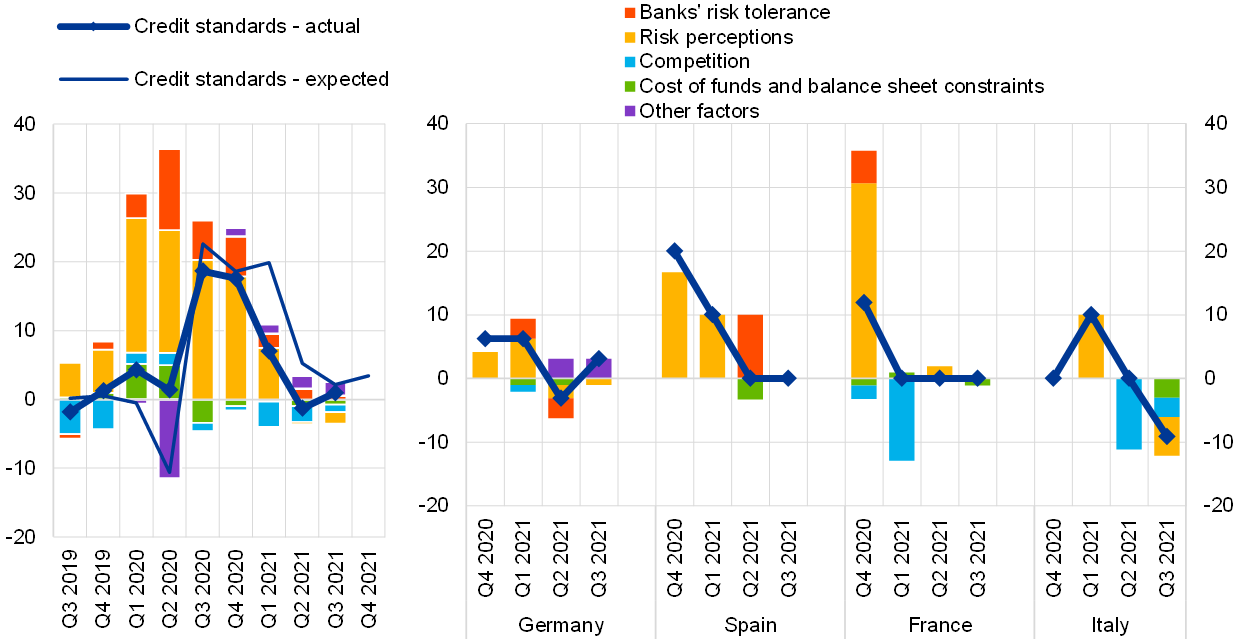
Notes: “Actual” values are changes that have occurred, while “expected” values are changes anticipated by banks. Net percentages are defined as the difference between the sum of the percentages of banks responding “tightened considerably” and “tightened somewhat” and the sum of the percentages of banks responding “eased somewhat” and “eased considerably”. The net percentages for responses to questions related to contributing factors are defined as the difference between the percentage of banks reporting that the given factor contributed to a tightening and the percentage reporting that it contributed to an easing. “Cost of funds and balance sheet constraints” is the unweighted average of “costs related to capital position”, “access to market financing” and “liquidity position”; “risk perceptions” is the unweighted average of “general economic situation and outlook”, “industry or firm-specific situation and outlook/borrower’s creditworthiness” and “risk related to the collateral demanded”; “competition” is the unweighted average of “competition from other banks”, “competition from non-banks” and “competition from market financing”. The net percentages for “other factors” refer to further factors which were mentioned by banks as having contributed to changes in credit standards, currently mainly related to the policy interventions in response to the COVID-19 pandemic.
Table 1
Factors contributing to changes in credit standards for loans or credit lines to enterprises
(net percentages of banks)

Note: See the notes on Chart 1.
In the largest euro area countries, credit standards for loans to enterprises eased in net terms in Italy, remained unchanged in Spain and France and tightened slightly in Germany. In Italy, risk perceptions related to the economic outlook and borrowers’ creditworthiness, competition from other banks as well as banks’ cost of funds and balance sheet constraints contributed to the net easing of credit standards.
In the fourth quarter of 2021, euro area banks expect a small net tightening of credit standards for loans to firms (net percentage of 3%), confirming their overall balanced view of credit risk looking ahead.
2.1.2 Terms and conditions on loans to enterprises eased slightly
Banks’ overall terms and conditions (i.e. banks’ actual terms and conditions agreed in the loan contract) for new loans to enterprises eased slightly in the third quarter of 2021 (net percentage of -2%, after -5%; see Chart 2 and Table 2). According to the banks, margins on average loans (defined as the spread over relevant market reference rates) narrowed in net terms, whereas margins on riskier loans widened moderately. Margin developments are overall consistent with the recent favourable development in firms’ aggregate cost of borrowing. The net tightening of collateral requirements continued to be small, whereas larger loan sizes contributed to a net easing of overall terms and conditions for loans to firms (included in “other terms and conditions”).
Chart 2
Changes in terms and conditions on loans or credit lines to enterprises
(net percentages of banks reporting a tightening of terms and conditions)
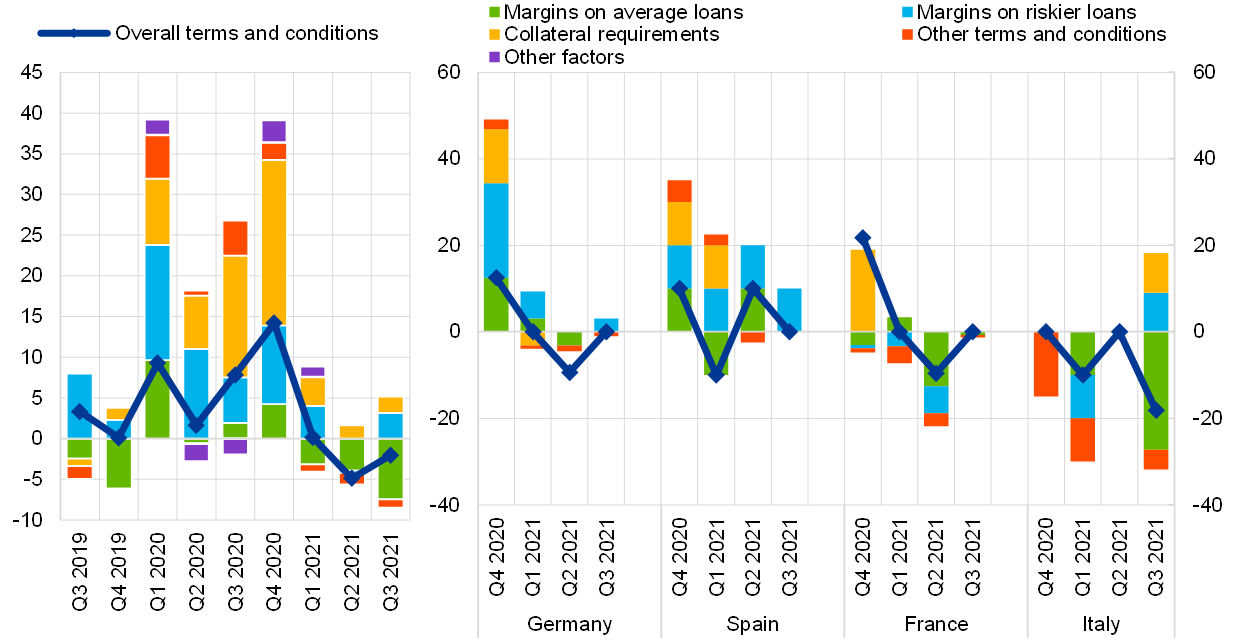
Notes: “Margins” are defined as the spread over a relevant market reference rate. “Other terms and conditions” is the unweighted average of “non-interest rate charges”, “size of the loan or credit line”, “loan covenants” and “maturity”. The net percentages for “other factors” refer to further factors which were mentioned by banks as having contributed to changes in terms and conditions.
Banks indicated competition as the main factor driving the overall slight easing in terms and conditions in the third quarter of 2021 (see Table 3). This could be explained by banks passing on the attractivSe funding conditions of TLTRO III, creating more competition among banks aiming to keep their market shares. Banks’ cost of funds and balance sheet constraints and risk perceptions did not contribute to changes in overall terms and conditions in the third quarter, whereas risk tolerance had a small net tightening impact.
In the largest euro area countries, overall terms and conditions on loans or credit lines to enterprises eased, on balance, in Italy and remained unchanged in Germany, Spain and France. Developments in Italy were explained by narrowing margins on average loans and other terms and conditions related to loan size. In Germany, Italy and Spain banks reported, on balance, wider margins on riskier loans. On top of this, banks reported a net tightening for the collateral demanded in Italy. The net easing of overall terms and conditions and the narrowing of margins on average loans in Italy was supported by pressures from competition. Lower risk tolerance contributed to the net tightening of margins on riskier loans in Spain and Italy, while risk perceptions and banks’ costs of funds also mattered in Italy.
Table 2
Changes in terms and conditions on loans or credit lines to enterprises
(net percentages of banks)

Note: See the notes on Chart 2.
Table 3
Factors contributing to changes in overall terms and conditions on loans or credit lines to enterprises
(net percentages of banks)

Note: The net percentages for these questions relating to contributing factors are defined as the difference between the percentage of banks reporting that the given factor contributed to a tightening and the percentage reporting that it contributed to an easing.
2.1.3 Rejection rate for loans to enterprises remained unchanged
In the third quarter of 2021, euro area banks continued to report on balance broadly no change in the share of rejected applications for loans to firms (net percentage of 1%, after 0% in the previous quarter; see Chart 3). This development is in line with banks’ broadly unchanged credit standards.
Across the largest euro area countries, banks in Germany reported a small net increase in the share of rejected applications, whereas banks in Spain reported a net decrease. Banks in France and Italy reported on balance no change in the share of rejected applications.
Chart 3
Changes in the rejection rate for loans to enterprises
(net percentages of banks reporting an increase in the share of rejections)
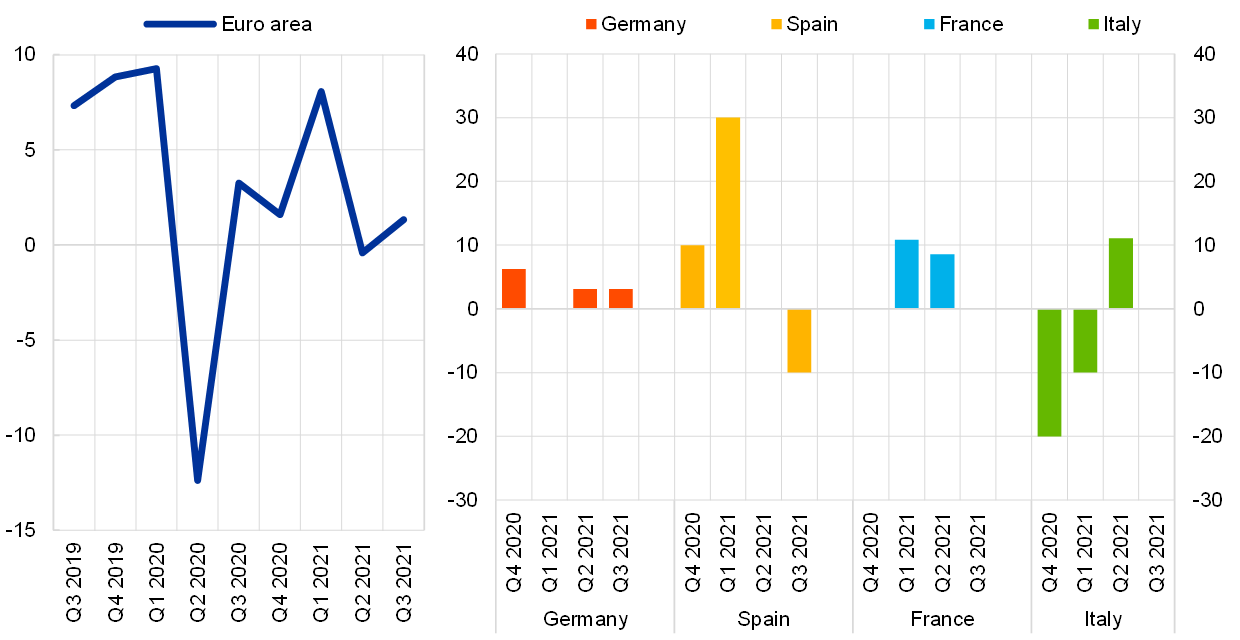
Notes: The net percentages for rejected loan applications are defined as the difference between the percentage of banks reporting an increase in the share of loan rejections and the percentage of banks reporting a decline. Banks’ responses refer to the share of rejected loan applications relative to the total volume of applications in that loan category.
2.1.4 Net demand for loans to enterprises increased slightly
Banks reported on balance a slight increase in firms’ demand for loans or credit lines in the third quarter of 2021 (net percentage of banks of 2%, after 8% in the second quarter of 2021; see Chart 4 and Overview table). This is the second consecutive increase since the extraordinarily high loan demand in the second quarter of 2020. Although smaller than the net increase in the previous quarter, this development is in line with the observed moderate growth in loans for July and August. Banks reported in net terms, broadly unchanged loan demand by SMEs (net percentage of 1%) and a stronger net increase for large firms (11%). While loan demand decreased on balance for short-term loans (-9%), it increased moderately for long-term loans (5%), confirming the observed recent shift towards longer loan maturities in firms’ borrowing from banks.
Loan demand continued to be supported by firms’ financing needs for fixed investment (see Chart 4 and Table 4), which is a positive sign for the economic recovery. In addition, banks continued to report a positive impact on loan demand from the low general level of interest rates and other financing needs related to M&A activity and debt refinancing and restructuring. Banks also reported a positive contribution from financing needs for inventories and working capital. By contrast, internal financing and alternative external financing sources (included in “use of alternative finance”) such as loans from other banks and non-banks and corporate bond issuance had a small negative impact on firms’ demand for bank loans. Finally, some banks mentioned a negative impact from supply bottlenecks, which dampened loan demand.
Chart 4
Changes in demand for loans or credit lines to enterprises, and contributing factors
(net percentages of banks reporting an increase in demand, and contributing factors)
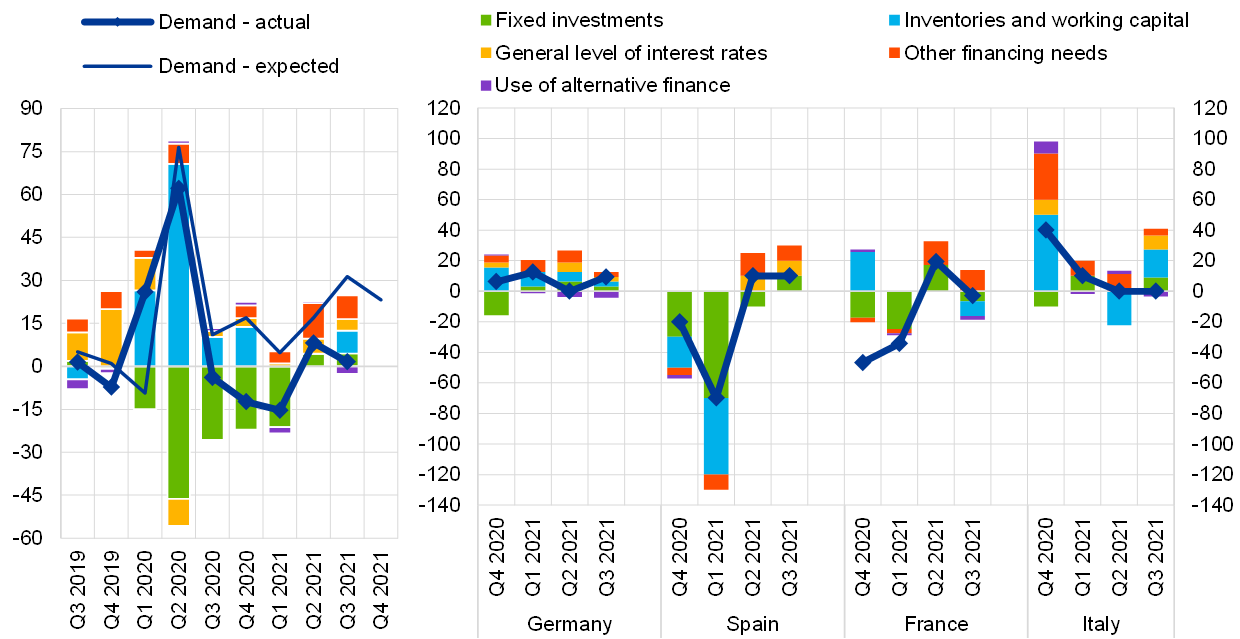
Notes: “Actual” values are changes that have occurred, while “expected” values are changes anticipated by banks. Net percentages for the questions on demand for loans are defined as the difference between the sum of the percentages of banks responding “increased considerably” and “increased somewhat” and the sum of the percentages of banks responding “decreased somewhat” and “decreased considerably”. The net percentages for responses to questions relating to contributing factors are defined as the difference between the percentage of banks reporting that the given factor contributed to increasing demand and the percentage reporting that it contributed to decreasing demand. “Other financing needs” is the unweighted average of “mergers/acquisitions and corporate restructuring” and “debt refinancing/restructuring and renegotiation”; “use of alternative finance” is the unweighted average of “internal financing”, “loans from other banks”, “loans from non-banks”, “issuance/redemption of debt securities” and “issuance/redemption of equity”.
Table 4
Factors contributing to changes in demand for loans or credit lines to enterprises
(net percentages of banks)

Note: See the notes on Chart 4.
In the largest euro area countries, banks reported a net increase in demand for loans to firms in Germany and Spain, unchanged net demand in Italy and a small net decrease in France. Financing needs related to fixed investment and the low general level of interest rates had a positive impact in Germany, Spain and Italy. In addition, M&A financing needs contributed positively to loan demand in Spain and France, while debt restructuring had a positive net impact on loan demand in all four countries. In Germany, France and Italy, the use of alternative finance had a negative net impact.
In the fourth quarter of 2021, euro area banks expect a stronger net increase in demand for loans by firms (net percentage of banks at 23%), with a somewhat larger increase by SMEs (net percentage of banks of 26%, compared with 23% for loans to large firms).
2.2 Loans to households for house purchase
2.2.1 Credit standards for loans to households for house purchase tightened
In the third quarter of 2021, euro area banks reported a net tightening of credit standards for loans to households for house purchase (net percentage of banks at 8%, after -1% in the previous quarter; see Chart 5 and Overview table), following a slight net easing in the first, and broadly unchanged credit standards in the second quarter of 2021. This suggests that euro area banks have adopted a somewhat more cautious attitude in their loan approvals for housing loans, as also visible in some terms and conditions related to loan-to-value ratio and maturity (see below).
Banks’ lower risk tolerance had a net tightening impact on credit standards (see Chart 5 and Table 5). In addition, their cost of funds and balance sheet constraints contributed to the net tightening of credit standards, while risk perceptions related to housing market prospects, the economic outlook and household creditworthiness had a broadly neutral impact on average. Finally, some banks have mentioned a net tightening impact of other factors related to macroprudential policy recommendations.
Chart 5
Changes in credit standards applied to the approval of loans to households for house purchase, and contributing factors
(net percentages of banks reporting a tightening of credit standards, and contributing factors)
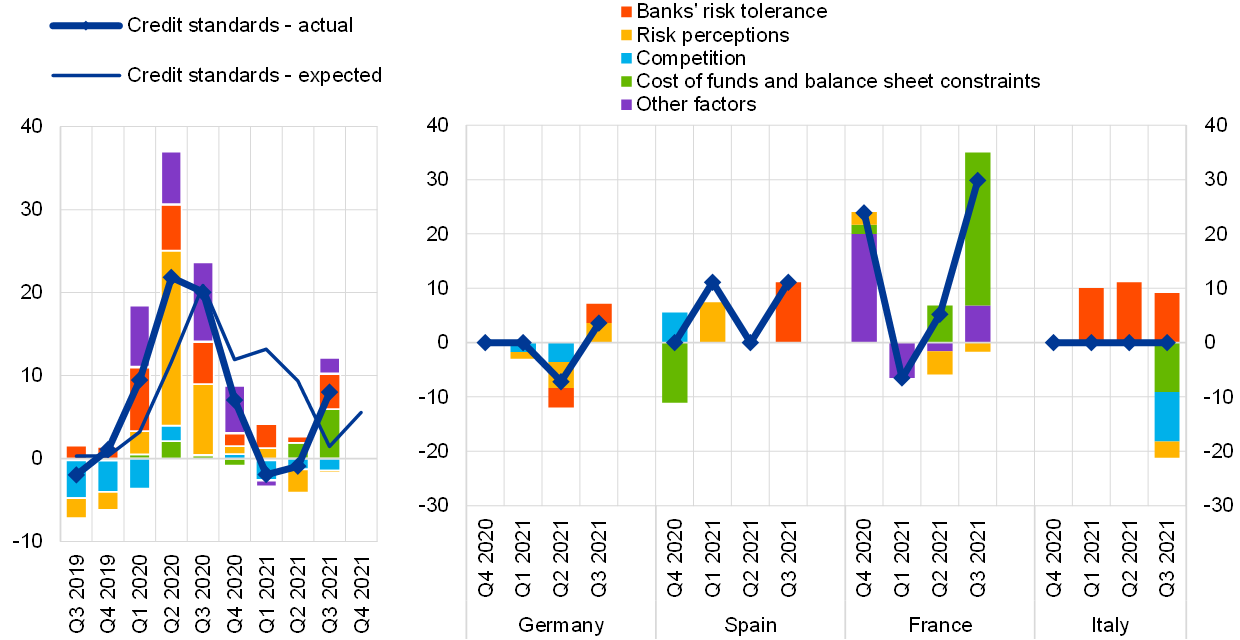
Notes: See the notes on Chart 1. “Risk perceptions” is the unweighted average of “general economic situation and outlook”, “housing market prospects, including expected house price developments” and “borrower’s creditworthiness”; “competition” is the unweighted average of “competition from other banks” and “competition from non-banks”. The net percentages for “other factors” refer to further factors which were mentioned by banks as having contributed to changes in credit standards, currently mainly related to macroprudential policy recommendations.
Regarding the largest euro area countries, credit standards tightened in Germany, Spain and France, whereas they remained unchanged in Italy. The tightening impact of banks’ lower risk tolerance was broad-based across the large countries and indicated by banks in Germany, Spain and Italy. Banks’ cost of funds and balance sheet situation had a neutral or easing impact in most of the large countries, except for France. In Italy, the net tightening impact of risk tolerance was counterbalanced by a net easing impact of risk perceptions, competitive pressures and cost of funds and balance sheet constraints. German banks also indicated a net tightening impact of risk perceptions, related to the economic outlook, housing market prospects and the creditworthiness of borrowers.
In the fourth quarter of 2021, euro area banks expect a further moderate net tightening of credit standards on loans to households for house purchase (net percentage of banks of 6%).
Table 5
Factors contributing to changes in credit standards for loans to households for house purchase
(net percentages of banks)

Note: See the notes on Chart 5.
2.2.2 Terms and conditions on loans to households for house purchase tightened
Banks reported on balance a moderate tightening of overall terms and conditions for housing loans (net percentage of banks of 5%, after -3% in the previous quarter; see Chart 6 and Table 6). This follows two quarters of moderate net easing in overall terms and conditions. Mirroring the historical low lending rates for housing loans, banks continued to report a narrowing of margins for both average and riskier loans, in net terms. At the same time, banks reported a slight net tightening of loan-to-value ratios, maturity and non-interest rate charges, in line with the more cautious attitude also visible in credit standards.
Chart 6
Changes in terms and conditions on loans to households for house purchase
(net percentages of banks reporting a tightening of terms and conditions)
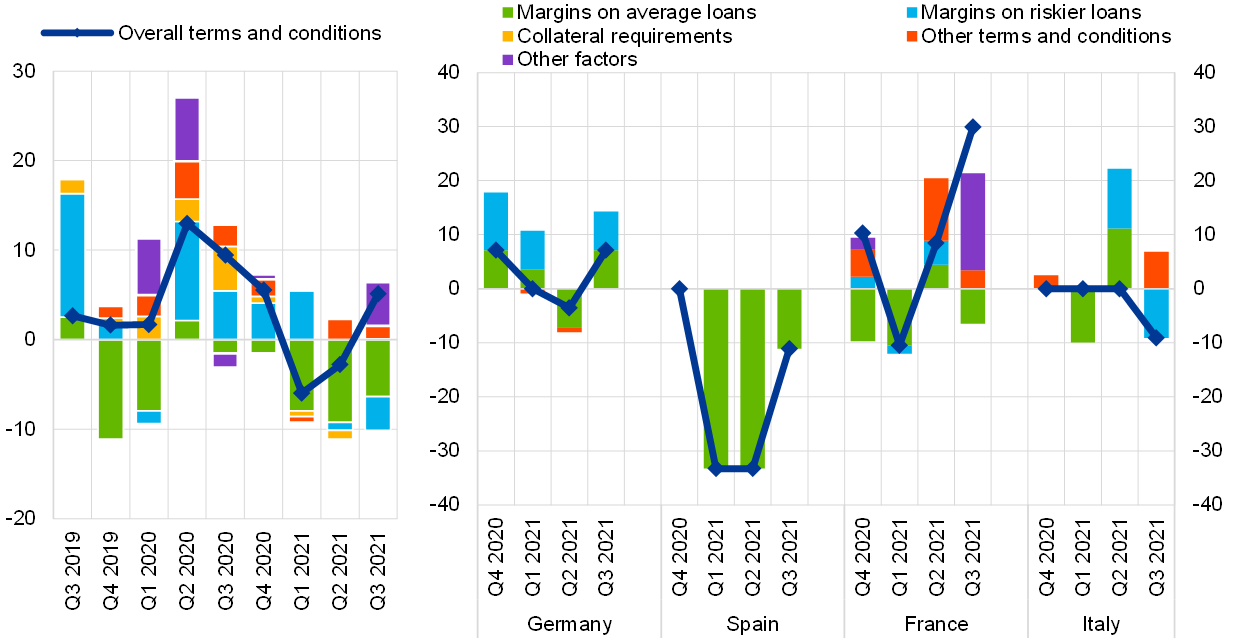
Notes: “Margins” are defined as the spread over a relevant market reference rate. “Other terms and conditions” is the unweighted average of “loan-to-value ratio”, “other loan size limits”, “non-interest rate charges” and “maturity”. The net percentages for “other factors” refer to further factors which were mentioned by banks as having contributed to changes in terms and conditions.
Table 6
Changes in terms and conditions on loans to households for house purchase
(net percentages of banks)

Note: See the notes on Chart 6.
Cost of funds and balance sheet constraints contributed moderately to the net tightening of terms and conditions, whereas risk perceptions and risk tolerance had a broadly neutral impact (see Table 7). By contrast, banks indicated a net easing impact from competitive pressures.
In the largest euro area countries, overall terms and conditions for housing loans tightened in Germany and in France, whereas they eased in Spain and Italy. The narrowing of margins in the euro area was driven by Spain and France for average loans and by Italy for riskier loans, while German banks reported a widening of all margins.
Table 7
Factors contributing to changes in overall terms and conditions on loans to households for house purchase
(net percentages of banks)

Note: The net percentages for these questions relating to contributing factors are defined as the difference between the percentage of banks reporting that the given factor contributed to a tightening and the percentage reporting that it contributed to an easing.
2.2.3 Rejection rate for housing loans increased slightly
In the third quarter of 2021, euro area banks reported a small net increase in the share of rejected applications for housing loans following a stronger net increase in the previous quarter (2%, after 11% in the previous quarter; see Chart 7). This is broadly in line with the net tightening of credit standards for loans to households for house purchase.
Chart 7
Changes in the rejection rate for loans to households for house purchase
(net percentages of banks reporting an increase in the share of rejections)
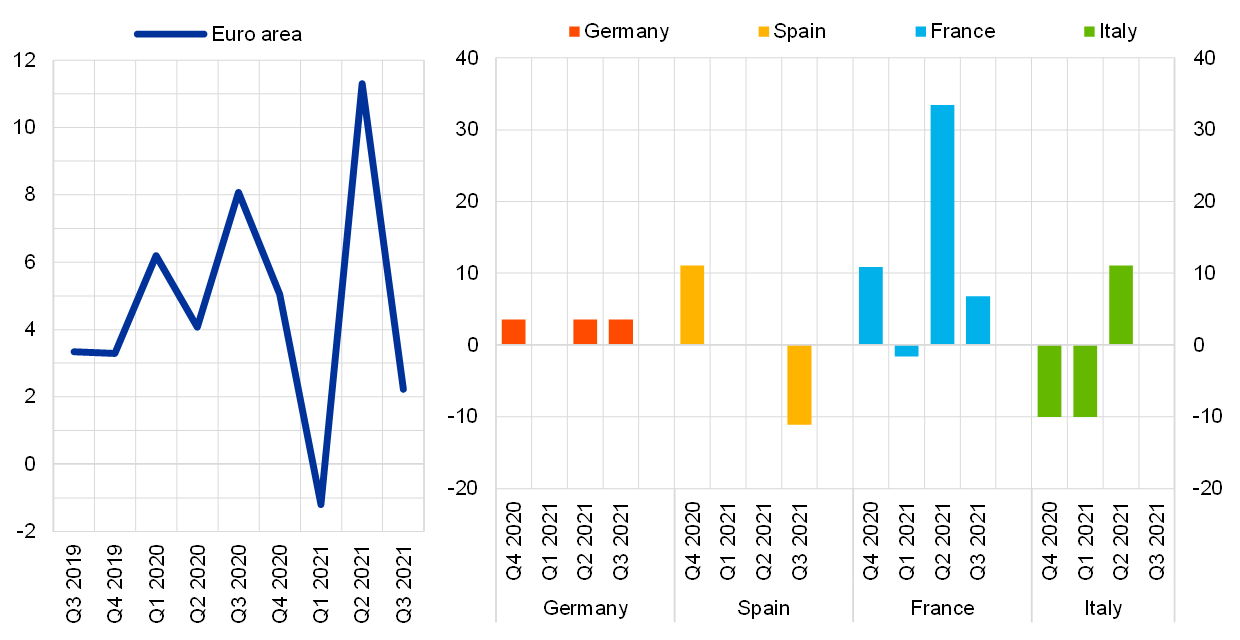
Notes: Net percentages for rejected loan applications are defined as the difference between the percentage of banks reporting an increase in the share of loan rejections and the percentage of banks reporting a decline. Banks’ answers refer to the share of rejected loan applications relative to the total volume of applications in that loan category.
Across the largest euro area countries, the rejection rate for housing loans increased in Germany and France, remained unchanged in Italy and decreased in net terms in Spain. As Germany and France are among the countries with the strongest growth in lending for house purchase, high loan demand may have contributed to the increase in the rejection rate.
2.2.4 Net demand for housing loans increased
Banks reported, in net terms, a continued increase in demand for housing loans in the third quarter of 2021, which was more contained after the strong increase in the previous quarter (net percentage of banks of 11%, after 36% in the second quarter of 2021; see Chart 8 and Overview table). This development is in line with the strong actual growth of loans to households for house purchase over the previous months.
Improving consumer confidence, the low general level of interest rates and favourable housing market prospects all continued to have a positive impact on demand for loans for house purchase (see Chart 8 and Table 8). Overall, this is consistent with recent evidence from the European Commission’s consumer sentiment survey on improving consumer confidence in the euro area in the third quarter, when compared with the previous quarter. In addition, other financing needs related to debt refinancing or restructuring of housing loans and housing market regulatory and fiscal regimes had a small positive impact on euro area housing loan demand. By contrast, households’ internal financing out of savings, as a source of alternative finance, had a small dampening impact on housing loan demand in the third quarter of 2021.
Chart 8
Changes in demand for loans to households for house purchase, and contributing factors
(net percentages of banks reporting an increase in demand, and contributing factors)
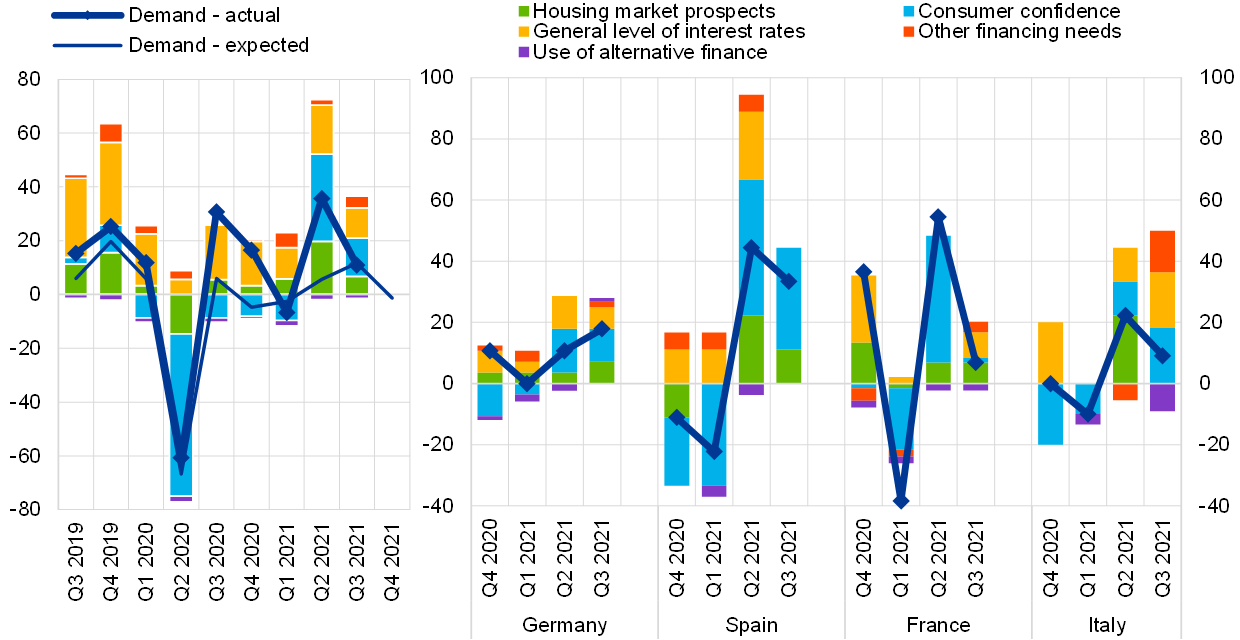
Notes: See the notes on Chart 4. “Other financing needs” is the unweighted average of “debt refinancing/restructuring and renegotiation” and “regulatory and fiscal regime of housing markets”; “use of alternative finance” is the unweighted average of “internal finance of house purchase out of savings/down payment”, “loans from other banks” and “other sources of external finance”.
In all the largest euro area countries, banks reported a net increase in housing loan demand in the third quarter of 2021. In Germany, Spain and Italy, and to a smaller extent in France, consumer confidence contributed to the net increase in demand for loans for house purchase. Housing market prospects had a positive impact in Germany, Spain and France, whereas the low general level of interest rates contributed positively in Germany, France and Italy. Other financing needs played a positive role for net demand developments in Italy, owing to the regulatory and fiscal regime and debt refinancing, and to a smaller extent in France and Germany. The use of alternative finance had a dampening effect in Italy and France.
In the fourth quarter of 2021, banks expect on balance broadly unchanged demand for housing loans (net percentage of banks of -1%).
Table 8
Factors contributing to changes in demand for loans to households for house purchase
(net percentages of banks)

Note: See the notes on Chart 8.
2.3 Consumer credit and other lending to households
2.3.1 Credit standards for consumer credit and other lending to households remained broadly unchanged
In the third quarter of 2021, credit standards for consumer credit and other lending to households remained broadly unchanged (net percentage of -1% after 0% in the previous quarter; see Chart 9 and Overview table). Following moderate to strong net tightening in previous pandemic quarters, banks reported broadly unchanged credit standards in the last two rounds.
Risk perceptions had a broadly neutral impact on credit standards for the first time since the start of the pandemic crisis (see Chart 9 and Table 9). In addition, banks’ risk tolerance, cost of funds and balance sheet constraints as well as competitive pressure from other banks and non-banks had a broadly neutral impact on credit standards.
Across the largest euro area countries, credit standards for consumer credit and other lending to households eased in Italy and Germany, supported by improved risk perceptions. At the same time, banks in Spain reported a net tightening, on account of lower risk tolerance. Banks in France reported unchanged credit standards.
In the fourth quarter of 2021, euro area banks expect credit standards for consumer credit and other lending to households to ease slightly (net percentage of -2%).
Chart 9
Changes in credit standards applied to the approval of consumer credit and other lending to households, and contributing factors
(net percentages of banks reporting a tightening of credit standards, and contributing factors)
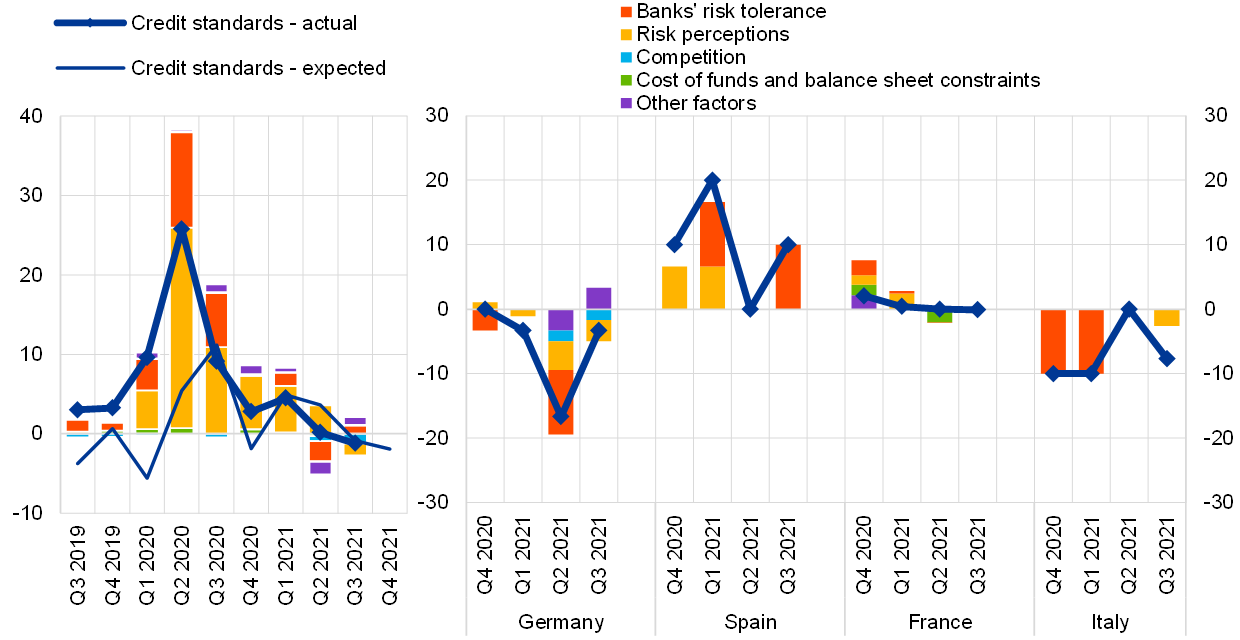
Notes: See the notes on Chart 1. “Risk perceptions” is the unweighted average of “general economic situation and outlook”, “creditworthiness of consumers” and “risk on the collateral demanded”; “competition” is the unweighted average of “competition from other banks” and “competition from non-banks”. The net percentages for “other factors” refer to further factors which were mentioned by banks as having contributed to changes in credit standards.
Table 9
Factors contributing to changes in credit standards for consumer credit and other lending to households
(net percentages of banks)
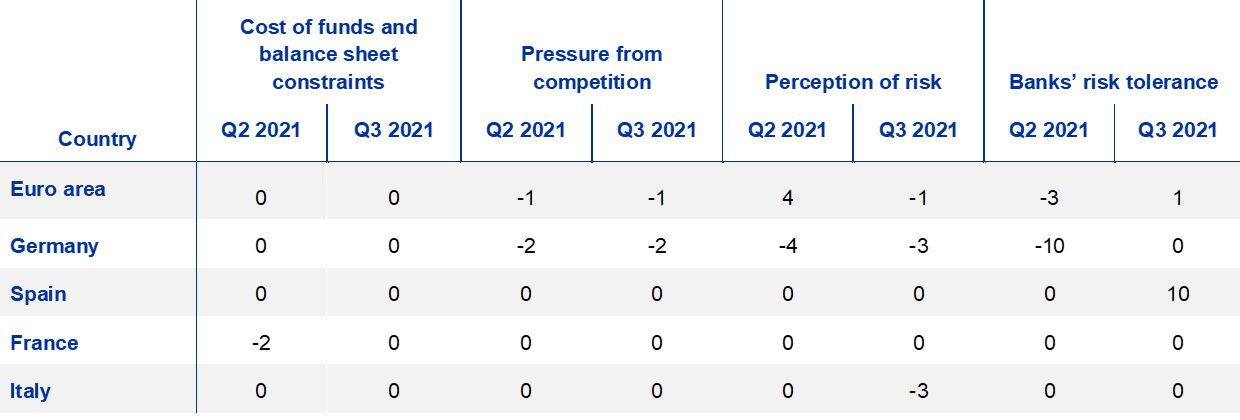
Note: See the notes on Chart 9.
2.3.2 Terms and conditions on consumer credit and other lending to households remained broadly unchanged
In the third quarter of 2021, banks’ overall terms and conditions applied when granting consumer credit and other lending to households remained broadly unchanged (net percentage of -1%, after -6% in the previous quarter; see Chart 10 and Table 10), supported by narrower margins on average loans and to a smaller extent by other terms and conditions, related to loan maturity.
Chart 10
Changes in terms and conditions on consumer credit and other lending to households
(net percentages of banks reporting a tightening of terms and conditions)
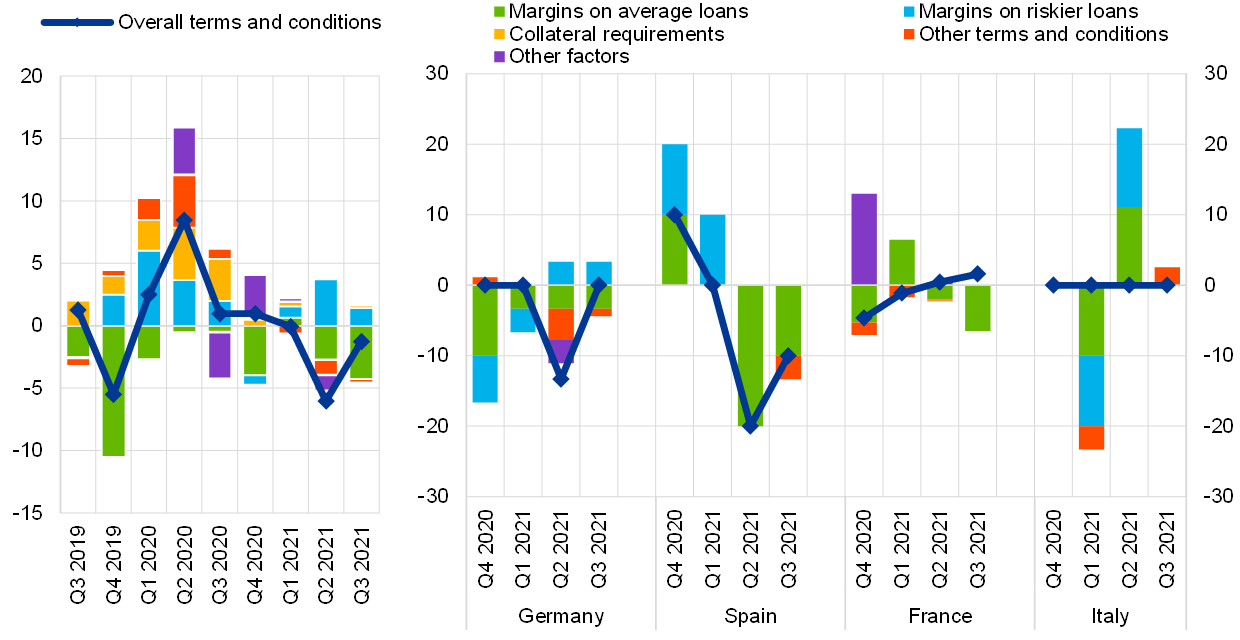
Notes: “Margins” are defined as the spread over a relevant market reference rate. “Other terms and conditions” is the unweighted average of “size of the loan”, “non-interest rate charges” and “maturity”. The net percentages for “other factors” refer to further factors which were mentioned by banks as having contributed to changes in terms and conditions.
Table 10
Changes in terms and conditions on consumer credit and other lending to households
(net percentages of banks)

Note: See the notes on Chart 10.
Pressure from competition had, on balance, an easing impact on banks’ overall terms and conditions for consumer credit (see Table 11). By contrast, banks’ risk tolerance had a small net tightening effect. Banks’ cost of funds and balance sheet constraints as well as risk perceptions had a broadly neutral impact on terms and conditions.
Across the largest euro area countries, overall terms and conditions on consumer credit and other lending to households eased in Spain, due to the easing impact of competition and risk perceptions. In Germany and Italy, overall terms and conditions on consumer credit were unchanged, whereas they tightened slightly in France, on account of higher cost of funds and balance sheet constraints.
Table 11
Factors contributing to changes in overall terms and conditions on consumer credit and other lending to households
(net percentages of banks)

Note: The net percentages for these questions relating to contributing factors are defined as the difference between the percentage of banks reporting that the given factor contributed to a tightening and the percentage reporting that it contributed to an easing.
2.3.3 Rejection rate for consumer credit and other lending to households decreased slightly
In the third quarter of 2021, euro area banks reported a small net decrease in the share of rejected applications for consumer credit and other lending to households (-2%, after 1% in the previous survey round; see Chart 11). This is consistent with unchanged credit standards for consumer credit and other lending to households.
In the largest euro area countries, the rejection rate on balance decreased in Germany and Italy, whereas it was broadly unchanged in Spain and France.
Chart 11
Changes in the rejection rate for consumer credit and other lending to households
(net percentages of banks reporting an increase in the share of rejections)
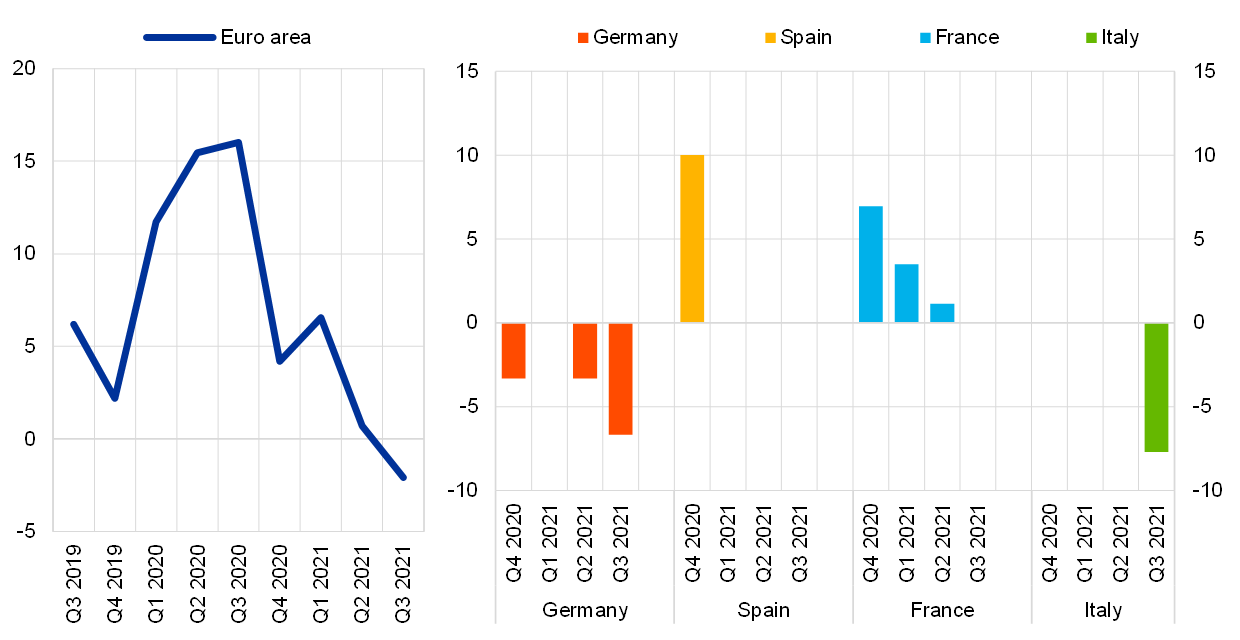
Notes: Net percentages for rejected loan applications are defined as the difference between the percentage of banks reporting an increase in the share of loan rejections and the percentage of banks reporting a decline. Banks’ responses refer to the share of rejected loan applications relative to the total volume of applications in that loan category.
2.3.4 Net demand for consumer credit and other lending to households increased
In the third quarter of 2021, banks reported, on balance, a moderate increase in demand for consumer credit and other lending to households (net percentage of banks at 7%, after 11% in the previous quarter; see Chart 12 and Overview table), following similar developments in the previous quarter. The net increase in demand was much lower than expected in the previous round and broadly reflects the observed subdued consumer credit growth.
Improved consumer confidence and spending on durables continued to have a positive impact on demand for consumer credit (see Chart 12 and Table 12). Overall, these developments are in line with recent survey evidence on improving consumer confidence in the euro area in the third quarter of 2021, in comparison with its level in the second quarter, as well as its pre-pandemic level, and with continued moderate consumption dynamics in the third quarter. In addition, the low general level of interest rates had a positive effect on demand for consumer credit while the use of alternative financing sources had a neutral impact.
Chart 12
Changes in demand for consumer credit and other lending to households, and contributing factors
(net percentages of banks reporting an increase in demand, and contributing factors)
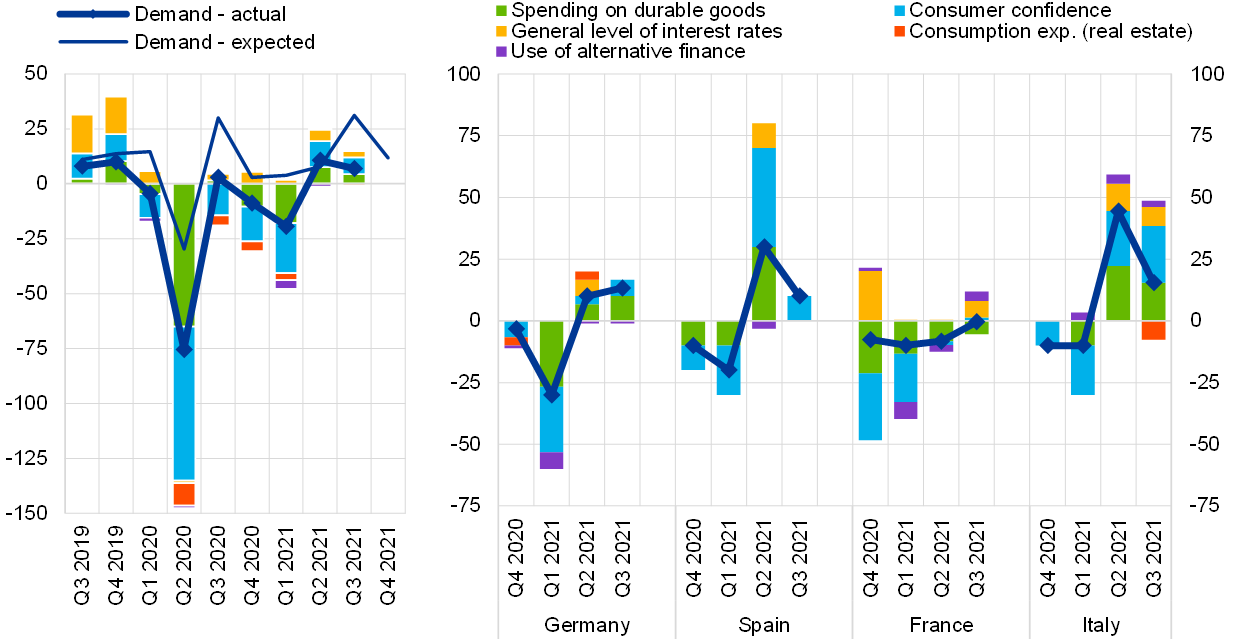
Notes: See the notes on Chart 4. “Use of alternative finance” is the unweighted average of “internal financing out of savings”, “loans from other banks” and “other sources of external finance”. “Consumption exp. (real estate)” denotes “consumption expenditure financed through real estate-guaranteed loans”.
Across the largest euro area countries, banks in Germany, Spain and Italy reported a net increase in demand for consumer credit. In all these countries, higher consumer confidence explained the net increase in demand. In addition, in Germany and Italy, demand for consumer credit was also driven by spending on durables. In Italy, the low general level of interest rates and the use of alternative sources of financing contributed positively to net demand, whereas consumption expenditure financed through real-estate guaranteed loans had a negative impact.
In the fourth quarter of 2021, banks expect a moderate net increase in demand for consumer credit and other lending to households (net percentage of 12%).
Table 12
Factors contributing to changes in demand for consumer credit and other lending to households
(net percentages of banks)

Note: See the notes on Chart 12.
3 Ad hoc questions
3.1 Banks’ access to retail and wholesale funding
The October 2021 survey included a question on the extent to which the situation in financial markets had affected banks’ access to retail and wholesale funding. Banks were asked whether their access to funding had deteriorated or eased over the past three months, as well as what their expectations were for the next three months. Here, negative net percentages indicate an improvement, while positive figures indicate a deterioration in net terms.
Chart 13
Banks’ assessment of funding conditions and the ability to transfer credit risk off the balance sheet
(net percentages of banks reporting a deterioration in market access)
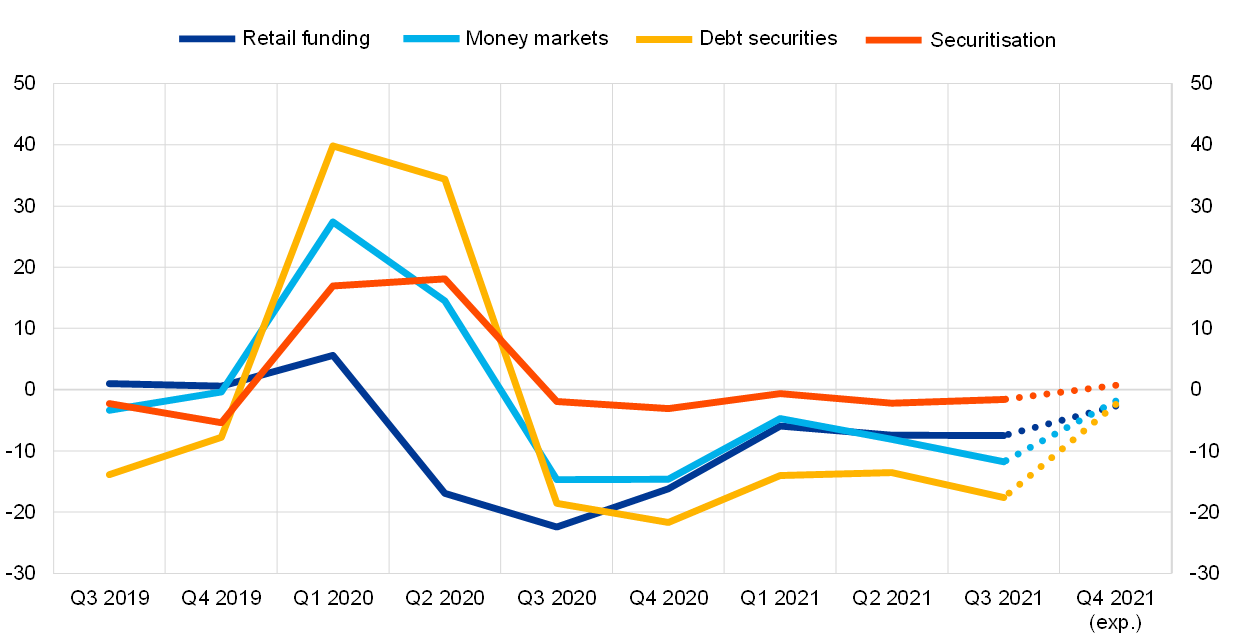
Note: The net percentages are defined as the difference between the sum of the percentages for “deteriorated considerably” and “deteriorated somewhat” and the sum of the percentages for “eased somewhat” and “eased considerably”.
Table 13
Banks’ assessment of funding conditions and the ability to transfer credit risk off the balance sheet
(net percentages of banks reporting a deterioration in market access)

Note: See the notes on Chart 13.
In the third quarter of 2021, euro area banks reported in net terms that their access to retail and wholesale funding continued to improve (see Chart 13 and Table 13). Access to money markets (net percentage of -12%, after -8% in Q2 2021) and to funding via debt securities (net percentage of -18%, after -14%) continued to improve in the third quarter of 2021. According to the banks, access to both short-term and medium- to long-term securities improved despite the increase in bank bond yields since the second half of August, indicating that monetary and supervisory policy continues to support banks’ access to funding. Access to securitisation continued to improve slightly in the third quarter of 2021 (-2%, after -2%).[5] Banks also reported, on balance, improved access to retail funding (-8%, after -7%). The improvement was again driven by short-term deposit funding as rates remain at historically low levels. This is also in line with deposit volumes remaining at elevated levels since the pandemic crisis started.
Looking ahead, in the fourth quarter of 2021, euro area banks expect their access to funding via money markets, debt securities and deposits to slightly improve further, while they expect access to securitisation to remain broadly unchanged.
3.2 The impact of the ECB’s asset purchase programmes
The October 2021 survey questionnaire included two biannual ad hoc questions gauging the impact of the ECB’s asset purchase programme (APP) and the pandemic emergency purchase programme (PEPP). When answering the questions on the impact of those programmes over the past and next six months, banks were asked to take into account the impact of the ECB’s net asset purchases and the reinvestment of the principal payments from maturing securities purchased. Banks were also asked to consider both the direct and indirect effects of the APP and PEPP, as there may be indirect effects on banks’ financial situation and asset allocation.
3.2.1 Impact of the ECB’s asset purchase programmes on banks’ financial situation
Euro area banks reported, in net terms, that the APP and PEPP contributed to a further improvement of their liquidity position and their market financing conditions, but to a deterioration of their profitability over the past six months (see Chart 14 and Chart 15). The reported net impact remained similar to the April BLS round (reporting on Q4 2020 to Q1 2021) for the liquidity position (net percentage of 33%, after 30% reporting an improvement) and market financing conditions (32%, after 32%). Banks also reported a more limited positive net impact on their total assets (net percentage of 11%). This was in part linked to a moderate positive net impact on sovereign bond holdings (4%). For profitability, banks reported a continued negative impact in net terms (net percentage of -18%, after -19%), while capital gains had a positive net impact.
Over the next six months, euro area banks expect, on balance, the APP and PEPP to have a continued positive impact on their liquidity position and their market financing conditions (net percentages of banks of 20% and 19%, respectively). In addition, banks expect the APP and PEPP to have a continued negative impact on their profitability (net percentage of -21%) over the next six months.
Chart 14
Overview of the impact of the ECB’s asset purchase programmes on euro area banks’ financial situation
(net percentages of banks, over the past and next six months)
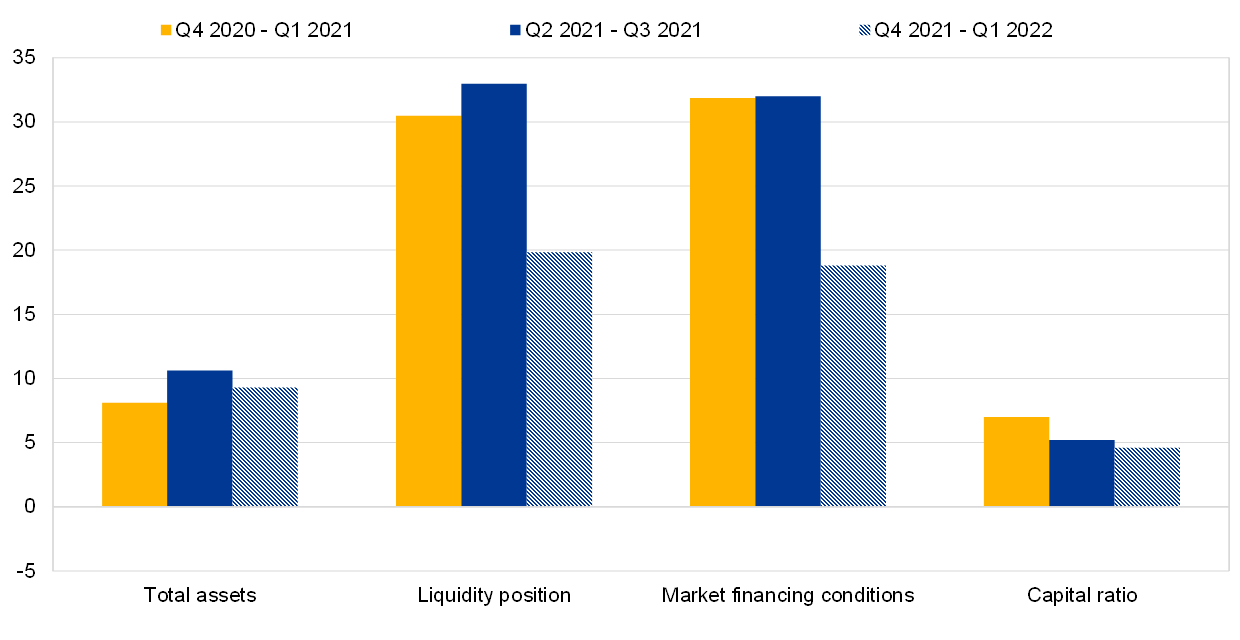
Notes: The net percentages are defined as the difference between the sum of the percentages for “increased/improved considerably” and “increased/improved somewhat” and the sum of the percentages for “decreased/deteriorated somewhat” and “decreased/deteriorated considerably”. The last period denotes expectations indicated by banks in the current round.
Chart 15
Impact of the ECB’s asset purchase programmes on bank profitability
(net percentages of banks, over the past and next six months)

Note: See the notes to Chart 14. The last period denotes expectations indicated by banks in the current round.
3.2.2 Impact of the ECB’s asset purchase programmes on banks’ lending conditions and lending volumes
Over the past six months, euro area banks reported, on balance, an easing impact of the APP and PEPP on their terms and conditions for loans to enterprises and housing loans (net percentages of banks of -8% and -4%, respectively), while the impact was again broadly neutral for consumer credit (-1%; see Chart 16). Regarding credit standards, banks only reported a moderate net easing impact on credit standards for loans to firms (net percentage of -4%, after 0%), while they reported a broadly neutral effect for loans to households.
Chart 16
Impact of the ECB’s asset purchase programmes on bank lending
(net percentages of banks, over the past and next six months)
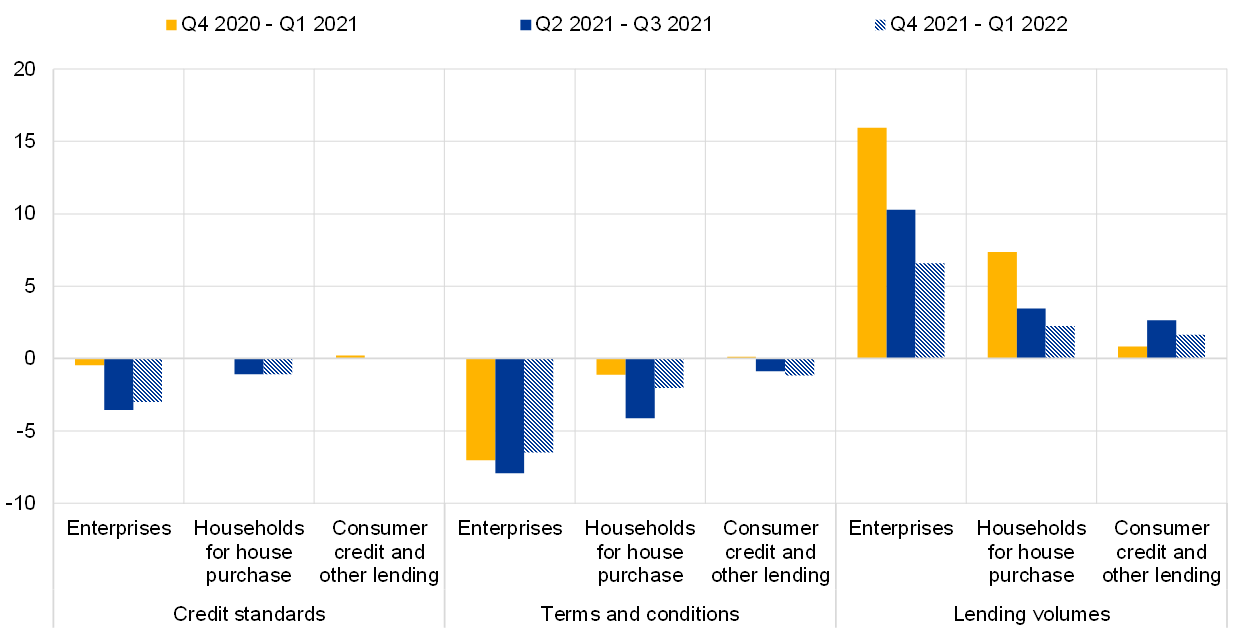
Notes: The net percentages are defined as the difference between the sum of the percentages for “tightened/increased considerably” and “tightened/increased somewhat” and the sum of the percentages for “eased/decreased somewhat” and “eased/decreased considerably”. The last period denotes expectations indicated by banks in the current round.
Over the next six months, banks expect, in net terms, the APP and PEPP to have a further easing impact on their terms and conditions for loans to enterprises and housing loans (net percentages of -6% and -2% respectively), while the expected impact remains broadly neutral for consumer credit and other lending to households (net percentage of -1%). In addition, banks expect a further moderate net easing impact on credit standards for loans to firms (-3%) over the next six months.
Euro area banks reported, in net terms, a positive impact of the APP and PEPP on lending volumes to firms and households over the past six months (see Chart 16). The impact was more pronounced for loans to firms (net percentage of 10%) than for housing loans and consumer credit (3% for each category).
Over the next six months, euro area banks expect a positive net impact on their lending volumes across all loan categories, albeit more muted for loans to households (net percentages of 7% for loans to enterprises, 2% for housing loans and 2% for consumer credit).
3.3 The impact of the ECB’s negative deposit facility rate and the ECB’s two-tier system
The October 2021 survey questionnaire included a biannual ad hoc question aimed at gauging the direct and indirect effects of the ECB’s negative deposit facility rate (DFR) and the ECB’s two-tier system. In the first part of the question, banks were asked to indicate the overall impact of the DFR, including the impact of the ECB’s two-tier system. In the second part of the question, banks were asked to single out the impact of the ECB’s two-tier system compared with the situation in which no two-tier system would exist. For both parts of the question, banks were asked to consider both the direct and indirect effects over the past and next six months.
3.3.1 Impact of the ECB’s negative deposit facility rate
Euro area banks reported, in net terms, that the ECB’s negative deposit facility rate (including the impact of the ECB’s two-tier system) had a negative impact on bank profitability over the past six months (net percentage of banks of -65%, after -63%; see Chart 17). This was again driven by a negative net impact on banks’ net interest income[6] (net percentage of -59%, after -58%) and is in line with low loan-to-deposit margins despite further progress in the pass-through of negative rates also to household deposits. Over the next six months, euro area banks expect the impact on their profitability and net interest income to be similar to the past six months.
Chart 17
Impact of the negative DFR on bank profitability
(net percentages of banks, over the past and next six months)

Notes: Includes the impact of the ECB’s two-tier system for remunerating excess liquidity holdings. The net percentages are defined as the difference between the sum of the percentages for “increased considerably” and “increased somewhat” and the sum of the percentages for “decreased somewhat” and “decreased considerably”. The last period denotes expectations indicated by banks in the current round.
Euro area banks continued to report, in net terms, that the negative DFR lowered lending rates across all loan categories (see Chart 18). The impact was more pronounced for loans to firms (-30%, after -32%) and housing loans (-28%, after -32%) than for consumer credit and other lending (-15%, after -25%). In line with the negative impact on net interest income, banks also reported a negative net impact on loan margins across loan categories.[7] Banks expect a similar net impact on lending rates over the next six months.
Chart 18
Impact of the negative DFR on bank lending
(net percentages of banks, over the past and next six months)
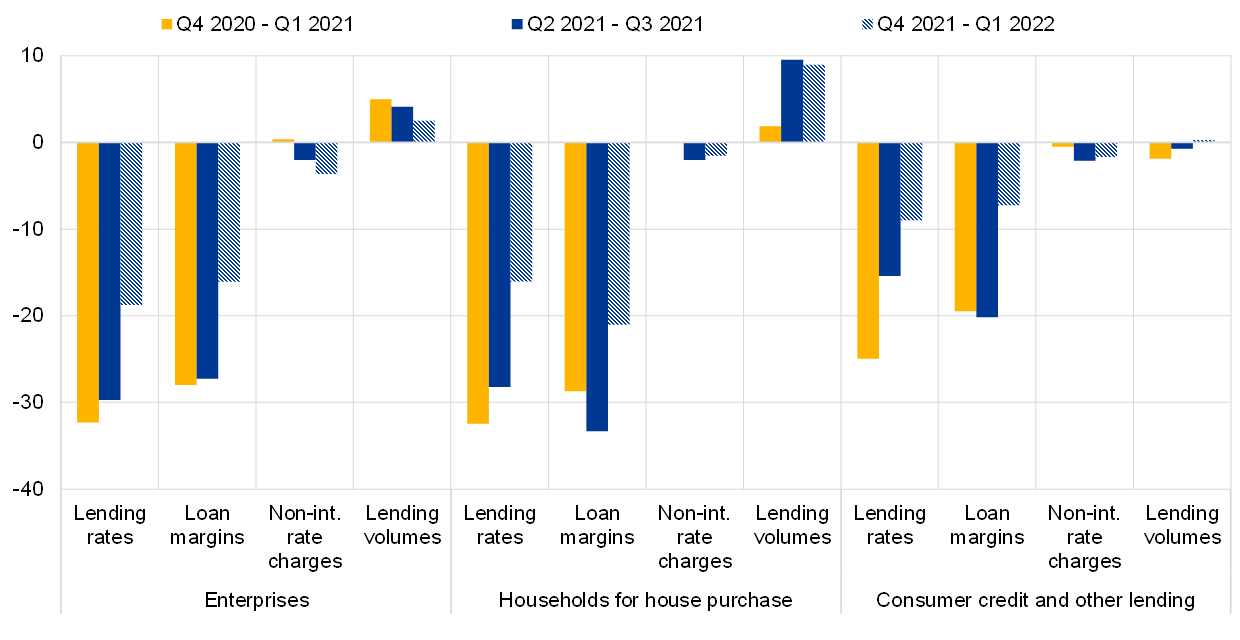
Notes: Includes the impact of the ECB’s two-tier system for remunerating excess liquidity holdings. The net percentages are defined as the difference between the sum of the percentages for “increased considerably” and “increased somewhat” and the sum of the percentages for “decreased somewhat” and “decreased considerably”. The last period denotes expectations indicated by banks in the current round.
Euro area banks reported, in net terms, a positive impact of the DFR on lending volumes for loans to enterprises and for housing loans (net percentages of 4% and 10%, respectively; see Chart 18), while the net impact was broadly neutral for consumer credit (net percentage of -1%). Over the next six months, banks expect a positive net impact on lending volumes to firms and to households for house purchase, while they expect no further change for consumer credit.
Euro area banks reported, in net terms, a continued negative impact of the DFR on deposit rates for enterprises and households over the past six months (net percentages of -40% and -33%, respectively; see Chart 19), in line with the continued decline in deposit rates over the past six months. Banks also reported a continued positive net impact on non-interest charges on deposits by firms and households (net percentages of 16% and 9%, respectively; see Chart 19), indicating an increased pass-through of negative rates also via this channel. Over the next six months, banks expect, on balance, the DFR to have a continued negative impact on deposit rates for firms and households.
Chart 19
Impact of the negative DFR on bank deposits
(net percentages of banks, over the past and next six months)

Notes: Includes the impact of the ECB’s two-tier system for remunerating excess liquidity holdings. The net percentages are defined as the difference between the sum of the percentages for “increased considerably” and “increased somewhat” and the sum of the percentages for “decreased somewhat” and “decreased considerably”. The last period denotes expectations indicated by banks in the current round.
Over the past six months, banks reported, in net terms, that the DFR had a moderate positive impact on deposit volumes both for firms and households (net percentages of 7% and 8%, respectively; see Chart 19). This reflects the fact that lower deposit rates due to the DFR have reduced the costs of this funding source for banks, while deposit inflows have remained solid due to there being few substitutes in the current low interest rate environment, as well as precautionary liquidity buffers held by firms and households. Over the next six months, banks expect the DFR to have a moderately negative net impact on deposit volumes by firms and a slightly positive net impact on deposit volumes by households.
3.3.2 Impact of the ECB’s two-tier system for remunerating excess liquidity holdings
Regarding the impact of the ECB’s two-tier system, compared with the situation in which no two-tier system would exist, a large net percentage of euro area banks reported a continued positive impact on their profitability (net percentage of 66%, after 58%; see Chart 20), mainly related to a positive impact on net interest income (69%, after 60%). In addition, a moderate net percentage of banks indicated a positive impact of the two-tier system on their liquidity position and market financing conditions (net percentages of 5% and 3%, respectively). Over the next six months, banks expect similar patterns to persist.
Euro area banks further reported that, on balance, the two-tier system led to higher deposit rates over the past six months compared with a situation with no such system (see Chart 21). By contrast, banks reported a broadly neutral impact on lending rates. The broadly neutral impact on lending rates for loans to firms (net percentage of 1%, after -8%), housing loans (0%, after -9%) and consumer credit (-1%, after -9%) followed a moderate negative impact reported in the April 2021 BLS round. Regarding deposit rates, a moderate net percentage of banks reported a positive impact for deposits held by firms (7%, after 5%) and by households (8%, after 3%). This reflects the fact that the funding-cost relief provided by the two-tier system allows banks to maintain margins with constant or lower lending rates and higher retail deposit rates, as also indicated by the positive impact of the two-tier system on net interest income (see above).
Chart 20
Impact of the ECB’s two-tier system on banks’ financial situation
(net percentages of banks, over the past and next six months)
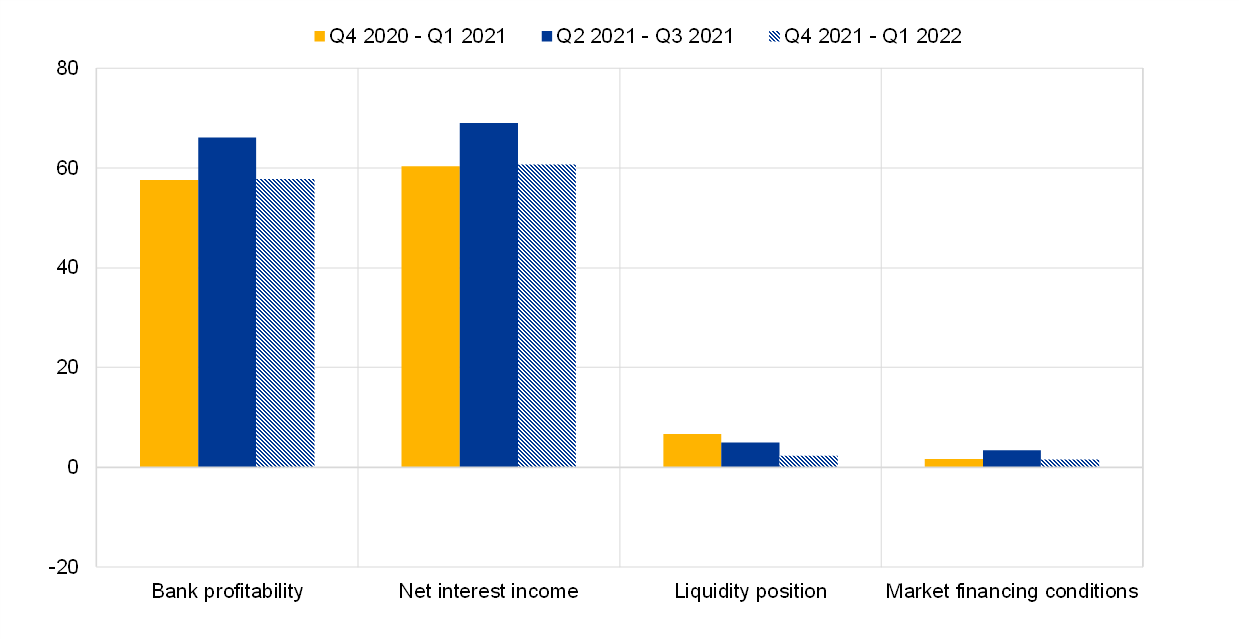
Notes: The net percentages are defined as the difference between the sum of the percentages for “improved considerably” and “improved somewhat” and the sum of the percentages for “deteriorated somewhat” and “deteriorated considerably”. The last period denotes expectations indicated by banks in the current round.
Chart 21
Impact of the ECB’s two-tier system on bank lending rates and bank deposit rates
(net percentages of banks, over the past and next six months)
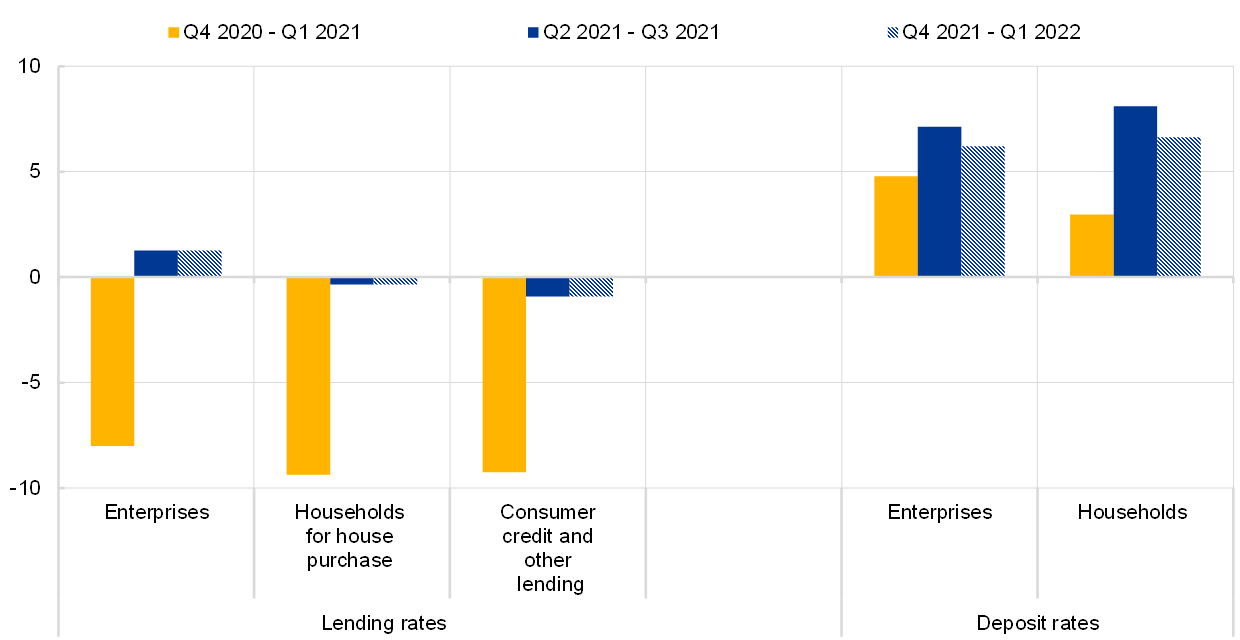
Notes: The net percentages are defined as the difference between the sum of the percentages for “increased considerably” and “increased somewhat” and the sum of the percentages for “decreased somewhat” and “decreased considerably”. The last period denotes expectations indicated by banks in the current round.
3.4 The impact of TLTRO III on banks and their lending policies
The October 2021 survey questionnaire included some ad hoc questions on the impact of the Eurosystem’s third series of targeted longer-term refinancing operations (TLTRO III). Banks were asked about their participation in that series of operations and their reasons for doing so, as well as about their use of TLTRO III liquidity. In addition, they were asked about the impact of TLTRO III on their financial situation, as well as on their lending conditions and lending volumes over the past six months and the next six months.
In the most recent two TLTRO III operations conducted in June and September 2021, 28% and 16% of BLS banks participated, respectively (see Chart 22). Participation was thus similar to the December 2020 operation and below the very large participation in the two operations in June 2020 and March 2021. This is in line with the lower overall take-up of TLTRO III funds in the recent two operations and in part reflects the reduced remaining borrowing allowances of banks due to high take-up in previous operations. Regarding future TLTRO III operations (the last one is scheduled for December 2021), 12% of banks report that they will participate, while 42% are undecided and 43% are not planning to participate.
Chart 22
Banks’ participation in TLTRO III and their reasons for participating
(percentages of banks)
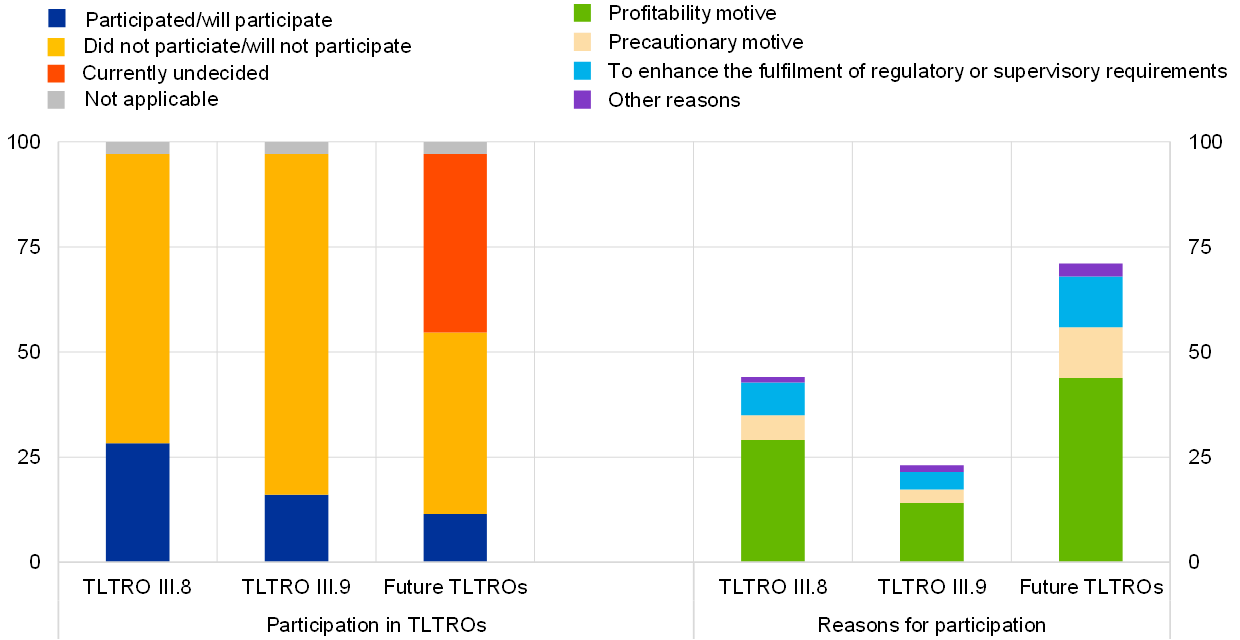
Notes: TLTRO III.8 in June 2021 corresponds to the “next to last TLTRO” in the questionnaire. TLTRO III.9 in September 2021 corresponds to the “most recent TLTRO”. Unweighted percentages of banks at national level for participation. Banks were asked to rate all reasons in terms of the extent to which they have contributed to their participation in TLTRO III. “Other reasons” are specific reasons cited by banks that were not included in the questionnaire.
The profitability motive (attractiveness of TLTRO III conditions) remained the most important reason for banks to participate in TLTRO III (29% of all BLS banks for the June 2021 operation, and 14% for the September 2021 operation; see Chart 22)[8], with the vast majority of participating banks mentioning this reason.[9] The precautionary motive, i.e. the avoidance or reduction of funding difficulties (6% in June and 3% in September) and the fulfilment of regulatory or supervisory requirements (8% in June and 4% in September) were less relevant for banks in the most recent two TLTRO III operations, and reported by around one quarter of participating banks.
For banks considering participation in future TLTRO III operations, the profitability motive remains the main reason for participating (44% of all banks). In addition, the fulfilment of regulatory or supervisory requirements and the precautionary motive are expected to be equally important reasons for participating in future TLTRO III operations (12% of banks for each reason).
Chart 23
Use of TLTRO III liquidity by banks
(percentages of banks, over the past and next six months)
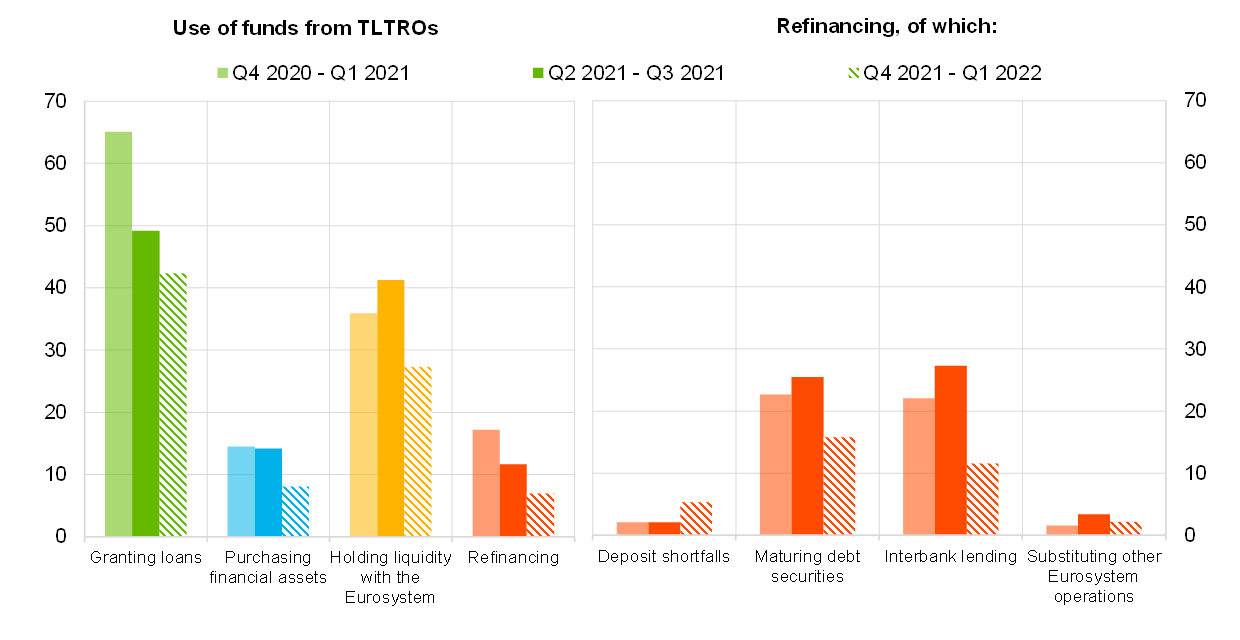
Notes: Banks were asked to indicate the relevance of all purposes. "Purchasing financial assets" is the average of “purchasing domestic sovereign bonds” and “purchasing other financial assets”. “Granting loans” refers to loans to the non-financial private sector. The last period denotes expectations indicated by banks in the current round.
Granting loans to the non-financial private sector remained the most common use of TLTRO III liquidity over the past six months (49% of BLS banks reported this use of funds, after 65% in the April round; see Chart 23). In addition, 41% (after 36%) of banks indicated holding TLTRO III liquidity with the Eurosystem as a further use of funds. Banks may use this liquidity for granting loans in the coming months. The use of TLTRO III liquidity by banks for refinancing purposes (percentage of banks at 12%, after 17%) and for purchasing assets (percentage of banks at 14%, after 15%) was more limited.[10]
Over the next six months, the purpose of granting loans remains the most important one, cited by 42% of euro area banks, while 27% referred to the purpose of holding liquidity with the Eurosystem. Banks expect the refinancing purpose to play a smaller role (mentioned by 7% of banks).
Banks indicated an overall positive impact of TLTRO III on their financial situation, mainly regarding their liquidity position, their market financing conditions and their profitability (see Chart 24). For all three categories banks reported a continued positive impact similar to the April 2021 BLS round. This implies that despite the lower take-up and participation, the large outstanding amounts of TLTRO III liquidity continue to support banks’ financial situation. Over the next six months, banks expect the positive impact to remain broadly similar.
Chart 24
Impact of TLTRO III on banks’ financial situation
(net improvement reported by banks, over the past and next six months)
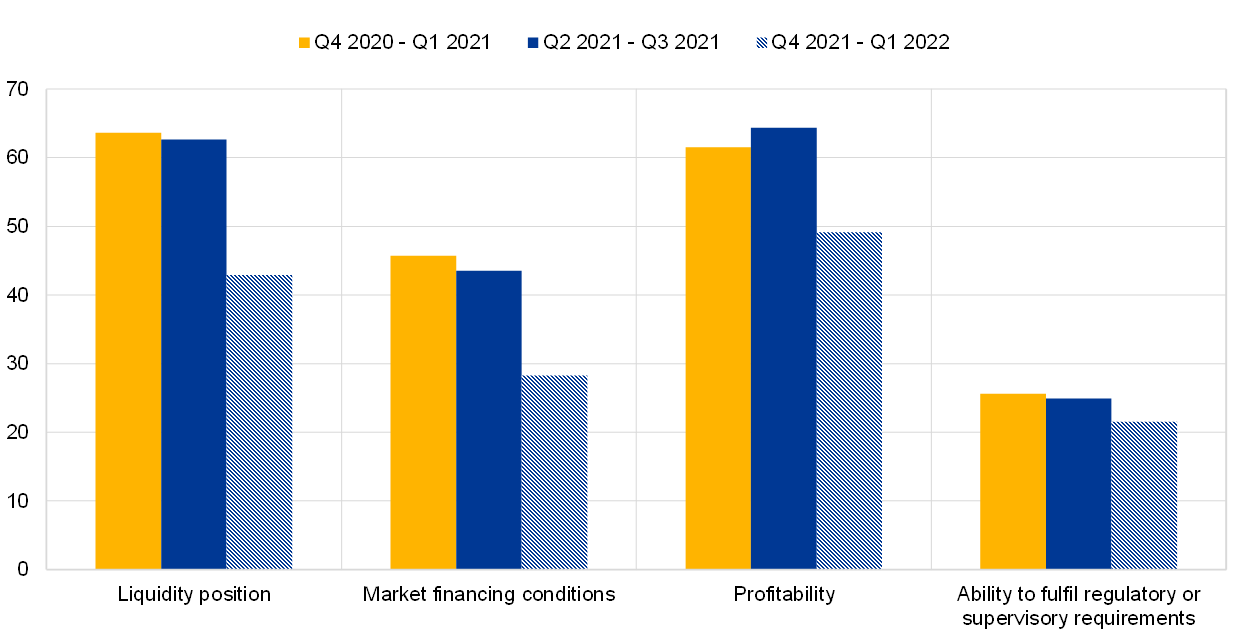
Notes: The signs for these net percentages have been inverted to show net improvements. The net improvement is defined as the difference between the sum of the percentages for “contributed considerably to an improvement” and “contributed somewhat to an improvement” and the sum of the percentages for “contributed somewhat to a deterioration” and “contributed considerably to a deterioration". The last period denotes expectations indicated by banks in the current round.
Banks reported, on balance, an easing impact of TLTRO III on their terms and conditions across all loan categories over the past six months (see Chart 25). The net percentage of banks reporting an easing impact on terms and conditions was larger for loans to enterprises (net percentages of -29%, after -27%), than for housing loans (-10%, after -4%) and consumer credit (-12%, after -4%). Regarding credit standards, TLTRO III had a moderate net easing impact for loans to firms (net percentage of -9%, after -8%), while there was a slight net easing impact for housing loans (-2%, after 0%) and a broadly neutral impact for consumer credit (-1%, after 0%).
A large net percentage of euro area banks continued to report a positive impact of TLTRO III on their lending volumes to enterprises over the past six months (net percentage of 42%, after 45%; see Chart 25). For lending to households, a larger net percentage of banks reported a positive impact of TLTRO III on lending volumes than in the April 2021 BLS round (net percentages of 18%, after 12% for housing loans and 20%, after 11% for consumer credit).
Over the coming six months, banks expect on balance a further net easing impact of TLTRO III on terms and conditions and a further positive net impact on lending volumes across all loan categories. The net percentages for the expected impact are close to the net percentages reported for the past six months.
Chart 25
Impact of TLTRO III on bank lending conditions and lending volumes
(net percentages of banks, over the past and next six months)
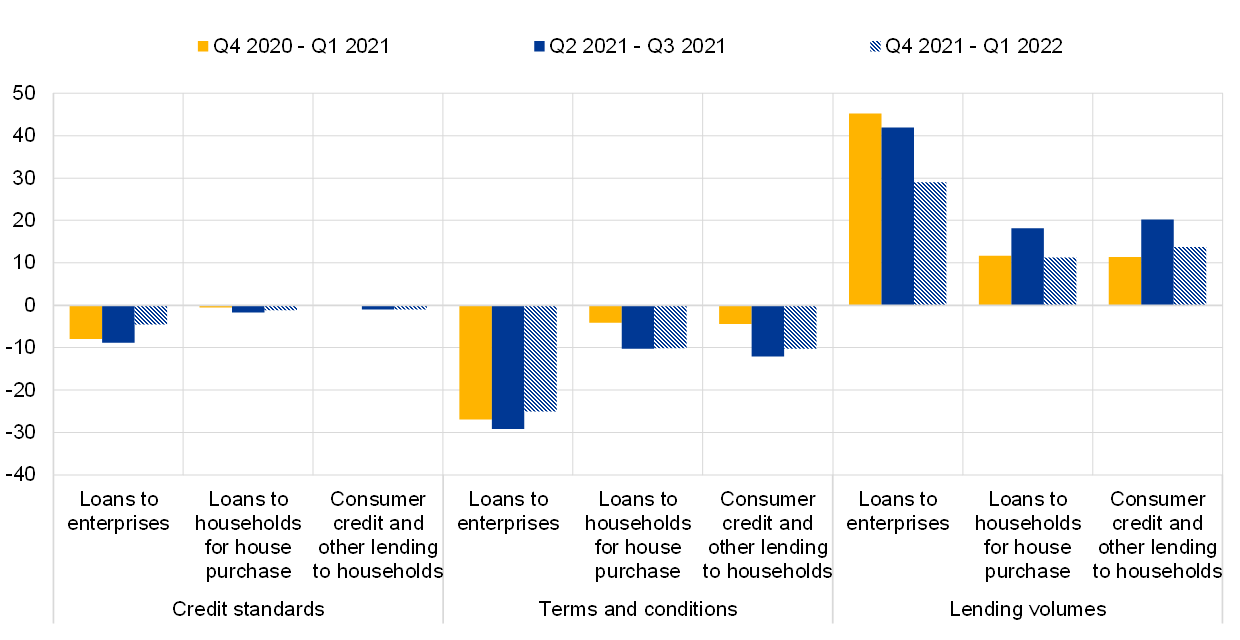
Notes: Net percentages are defined as the difference between the sum of the percentages for “contributed considerably to a tightening or increase” and “contributed somewhat to a tightening or increase” and the sum of the percentages for “contributed somewhat to an easing or decrease” and “contributed considerably to an easing or decrease". The last period denotes expectations indicated by banks in the current round.
Annexes
See more.
© European Central Bank, 2021
Postal address 60640 Frankfurt am Main, Germany
Telephone +49 69 1344 0
Website www.ecb.europa.eu
All rights reserved. Reproduction for educational and non-commercial purposes is permitted provided that the source is acknowledged.
For specific terminology please refer to the ECB glossary (available in English only).
PDF ISSN 1830-5989, QB-BA-21-004-EN-N
HTML ISSN 1830-5989, QB-BA-21-004-EN-Q
- The four largest euro area countries in terms of GDP are Germany, France, Italy and Spain.
- For more detailed information on the bank lending survey, see the article entitled “A bank lending survey for the euro area”, Monthly Bulletin, ECB, April 2003; Köhler-Ulbrich, P., Hempell, H. and Scopel, S., “The euro area bank lending survey”, Occasional Paper Series, No 179, ECB, 2016; and Burlon, L., Dimou, M., Drahonsky, A. and Köhler-Ulbrich, P., “What does the bank lending survey tell us about credit conditions for euro area firms?”, Economic Bulletin, Issue 8, ECB, December 2019.
- In this case, the selected sample banks are generally of similar size or their lending behaviour is typical of a larger group of banks.
- The non-harmonised historical data differ from the harmonised data mainly as a result of heterogeneous treatment of “NA” (Not Applicable) replies and specialised banks across questions and countries. Non-harmonised historical BLS data are published for discontinued BLS questions and ad hoc questions.
- For the results on securitisation, there are a large number of banks that replied “Not Applicable” as this source of funding is not relevant for them (between 47% and 61% depending on the type of securitisation in the third quarter of 2021).
- Net interest income is defined as the difference between the interest earned and interest paid on the outstanding amount of interest-bearing assets and liabilities by the bank.
- The loan margin is defined as the spread of the bank’s lending rates on new loans over a relevant market reference rate.
- Banks which participated in the respective TLTRO III operation or may participate in future operations are asked about their reasons for participating and can indicate more than one reason. The lower share of this reason for the September 2021 operation is thus due to the lower participation rate and the fact that the percentage share refers to all banks.
- This results from comparing the net percentages to the respective participation rates based on weighted net percentages.
- Banks may have also used the additional take-up of TLTRO III funding over the past six months to roll over existing TLTRO III funds for which early repayment became available in September 2021. However, this purpose was not reflected in the questionnaire.
-
26 October 2021


